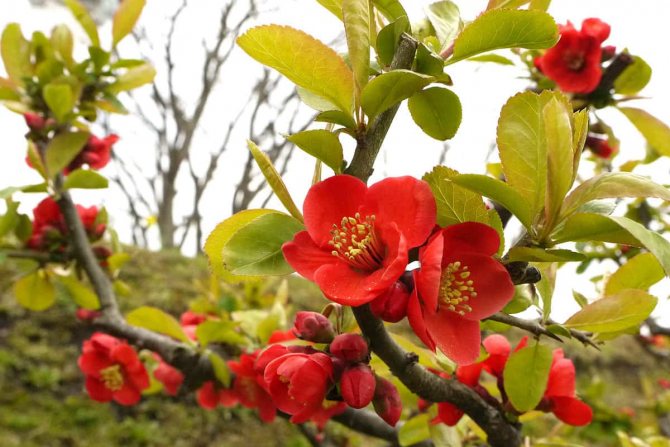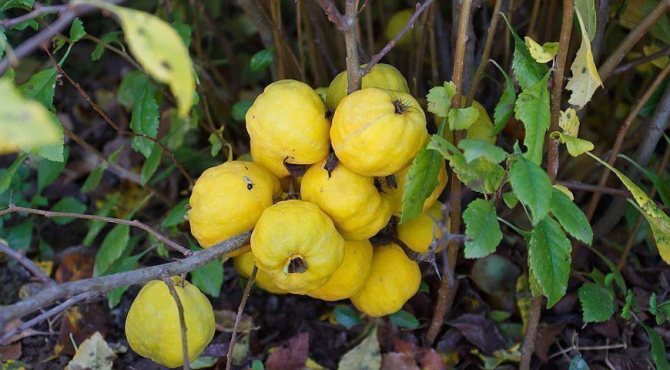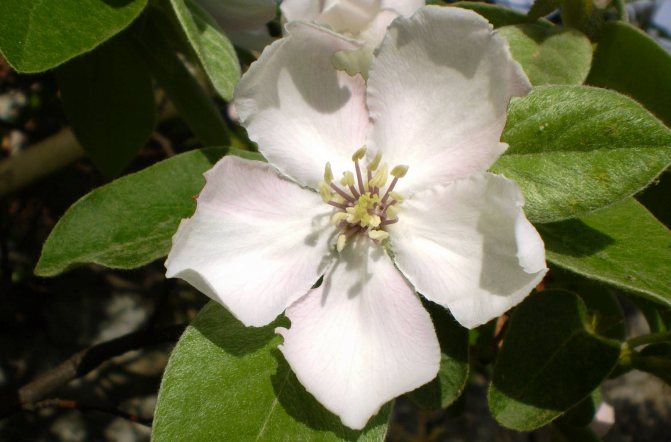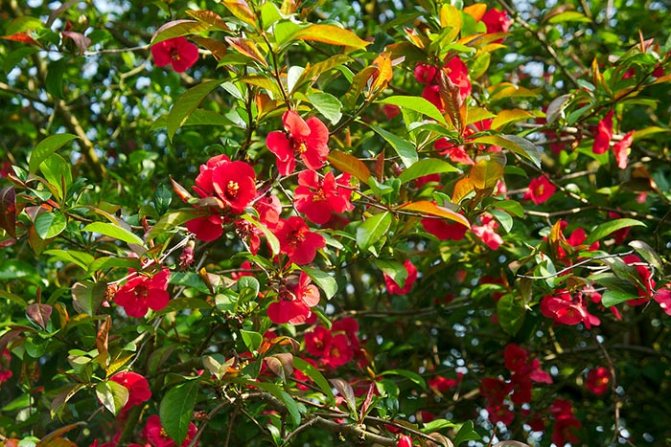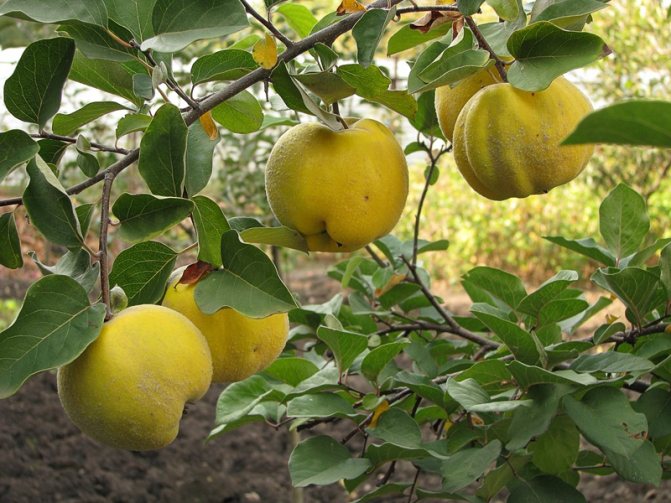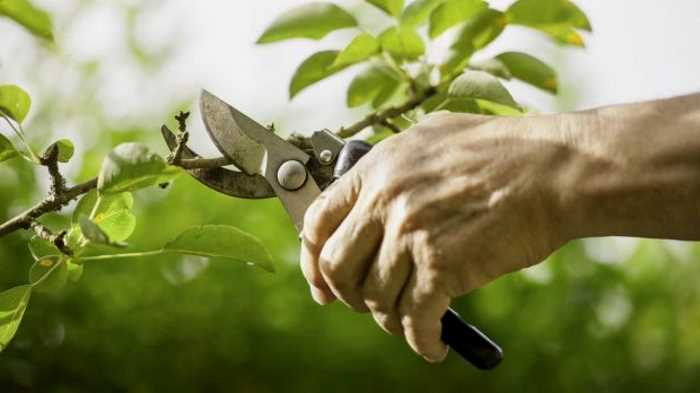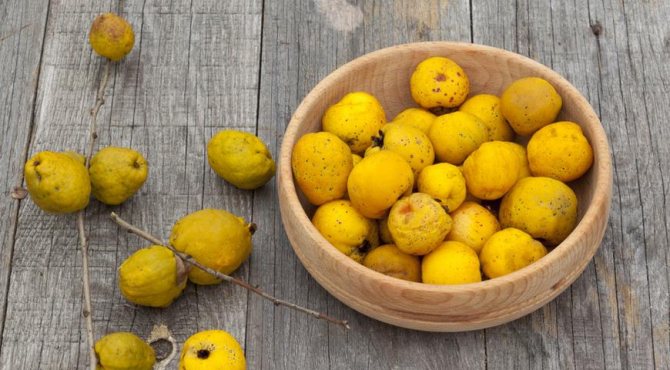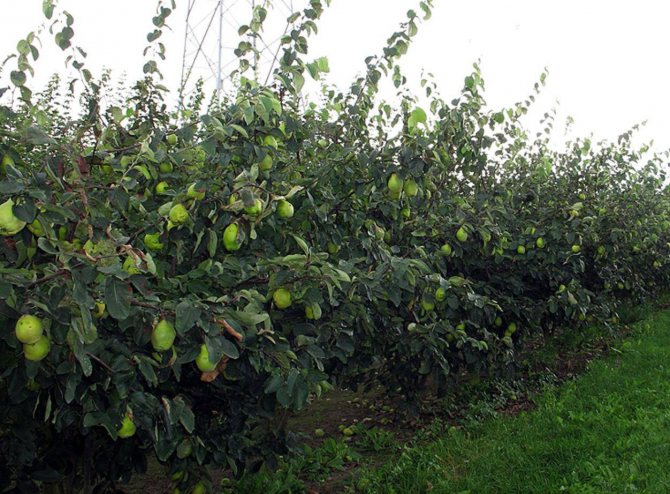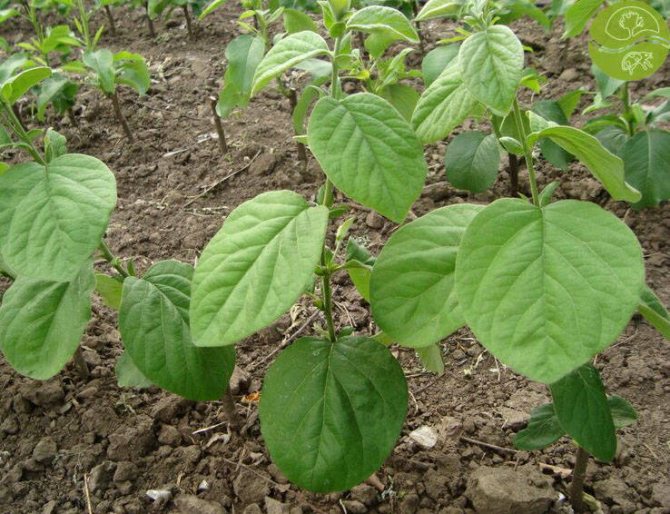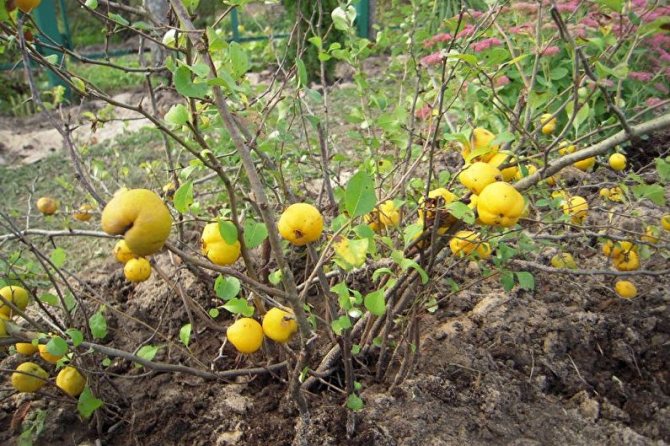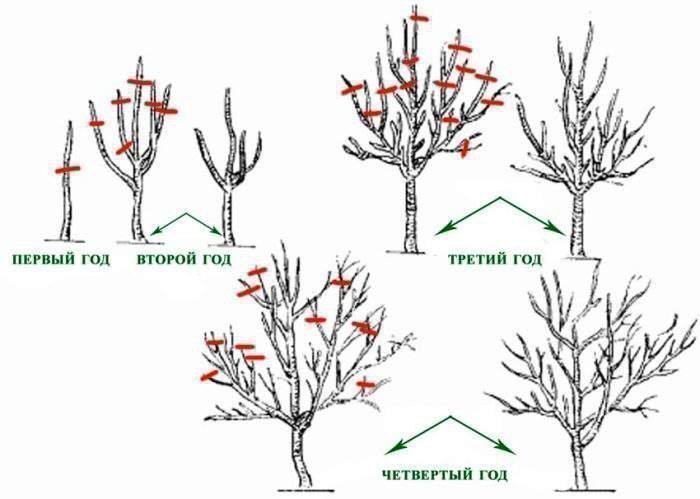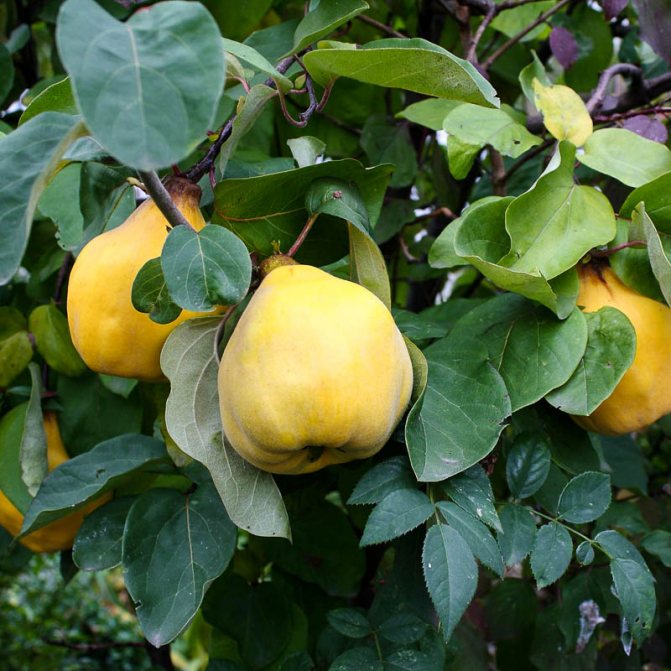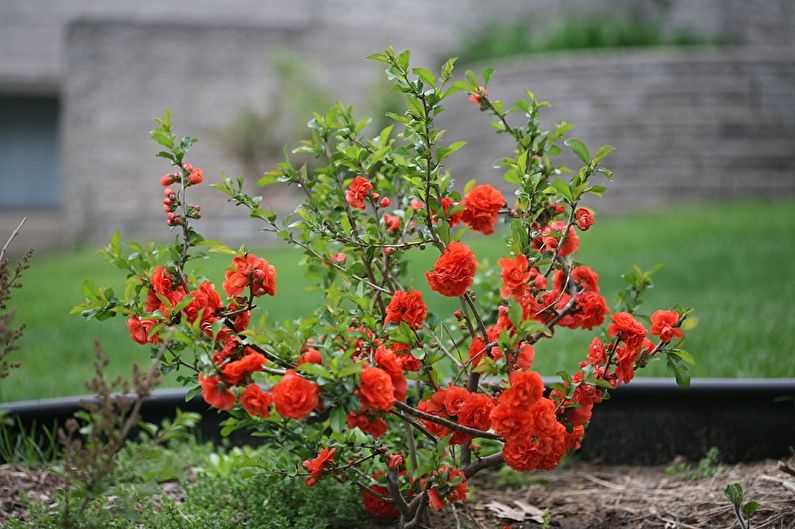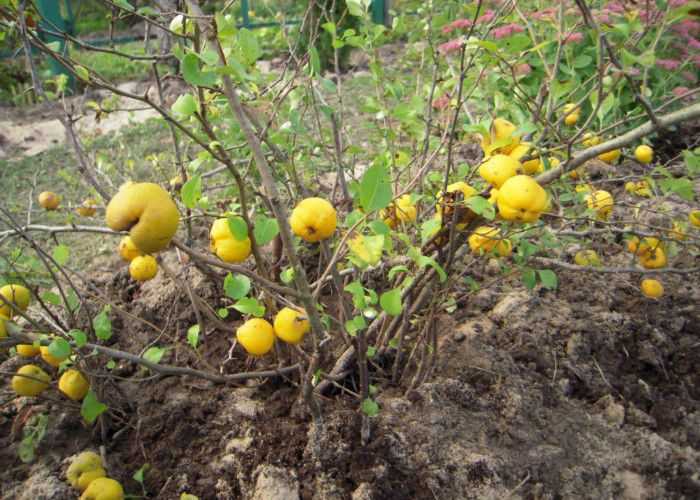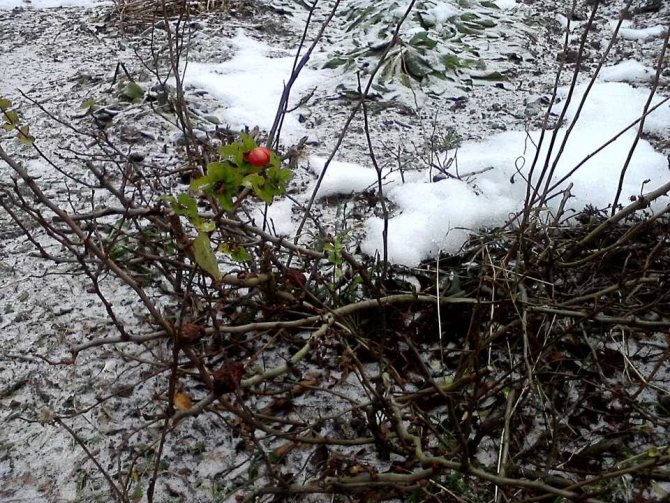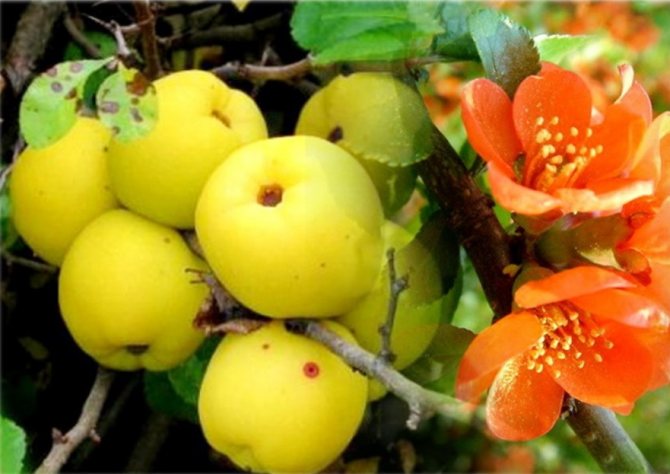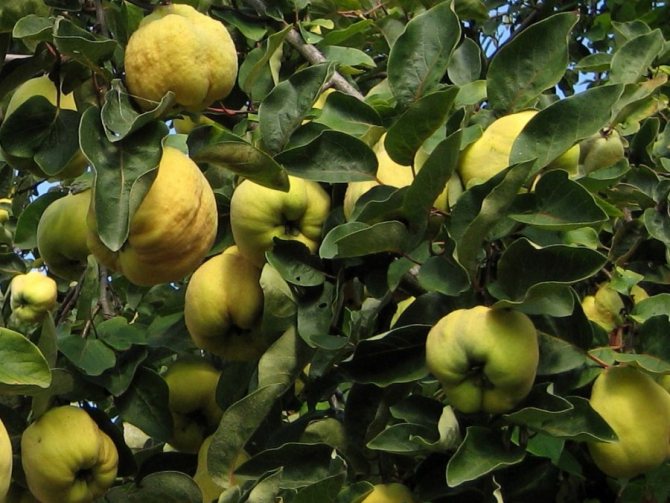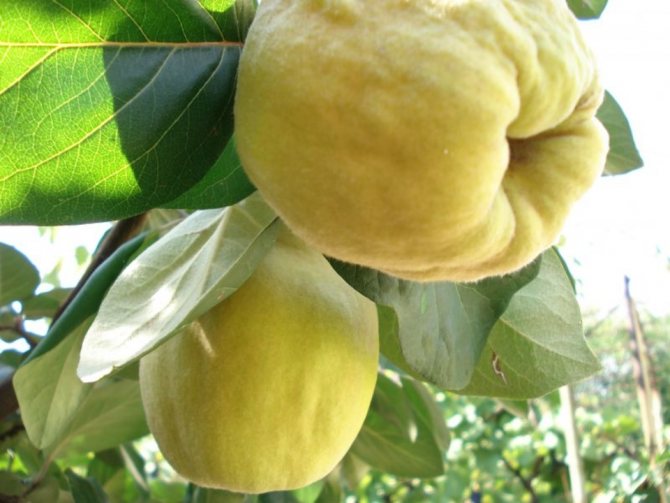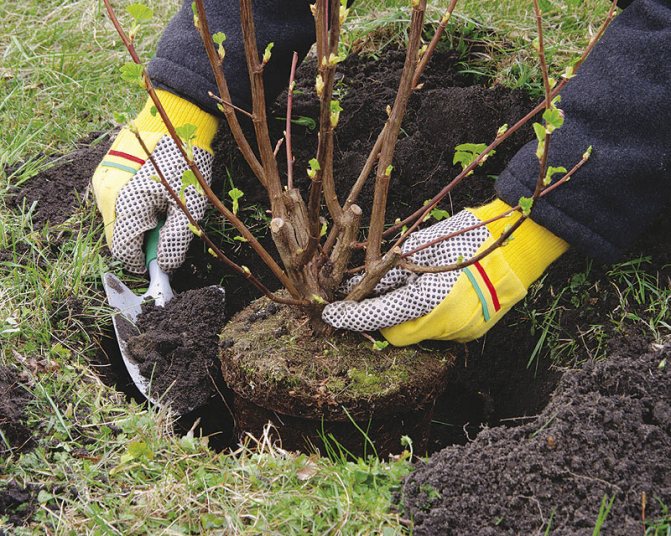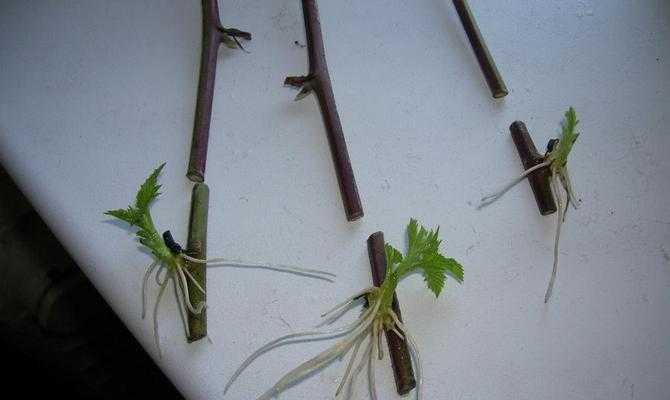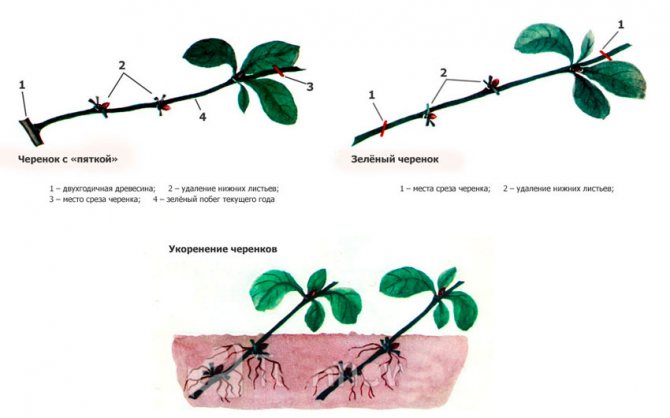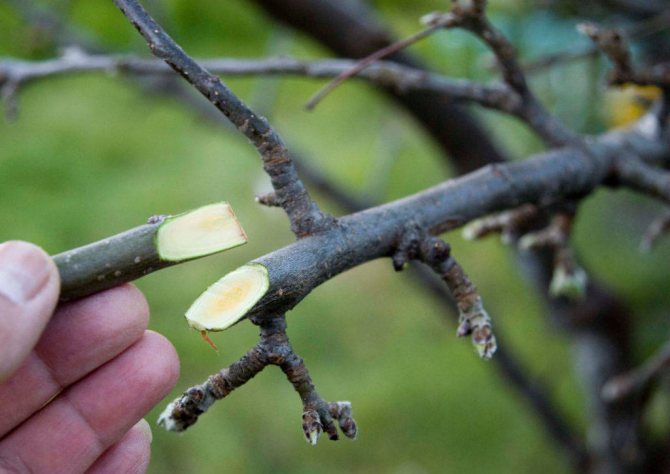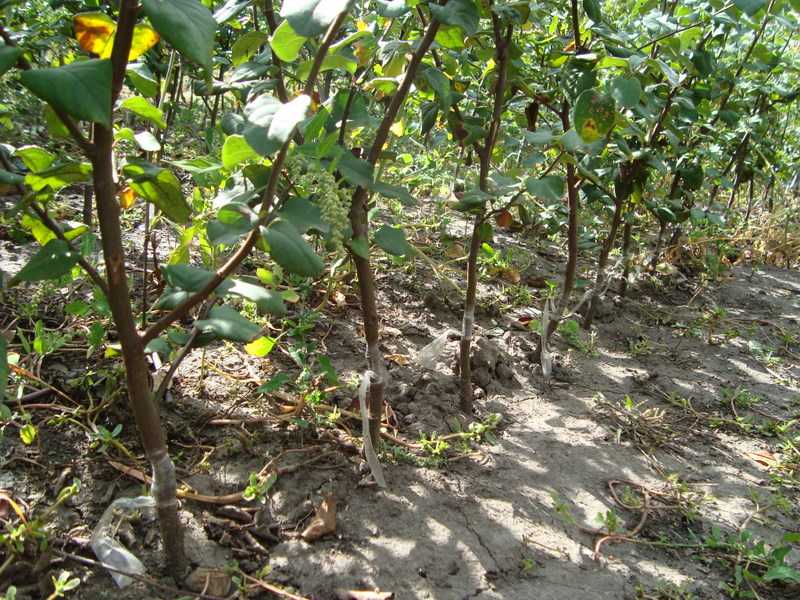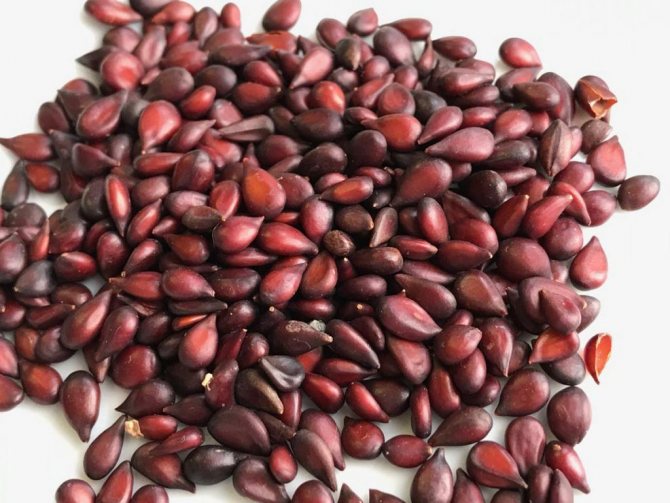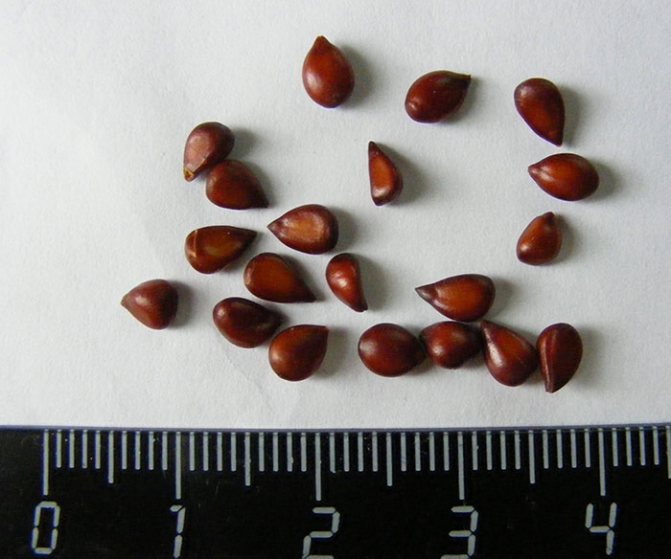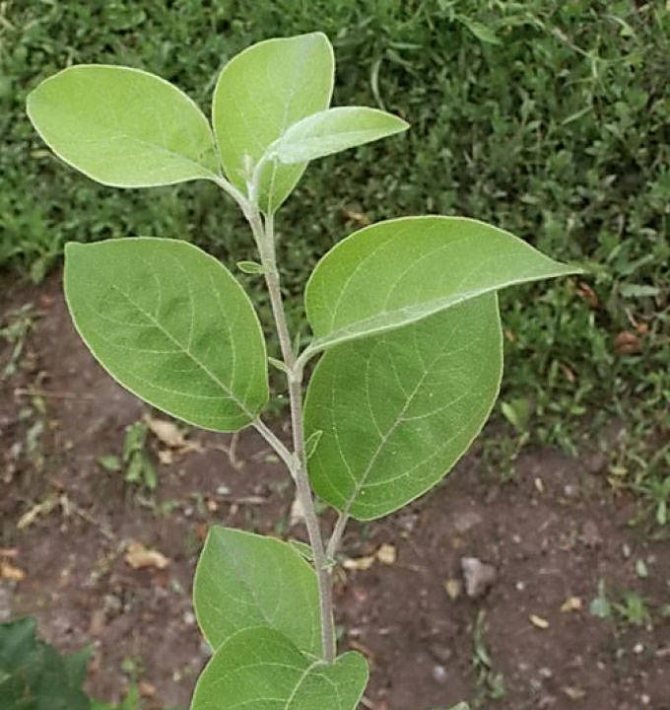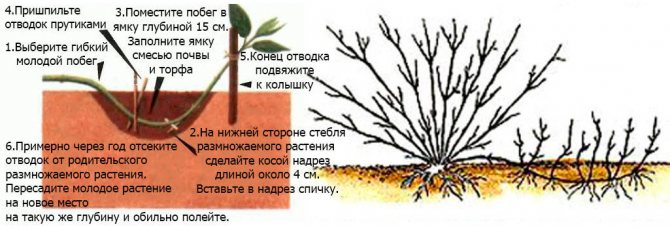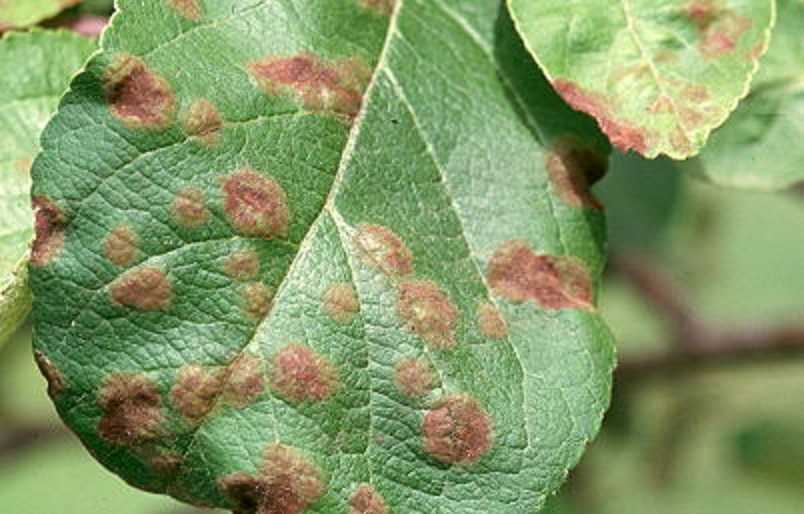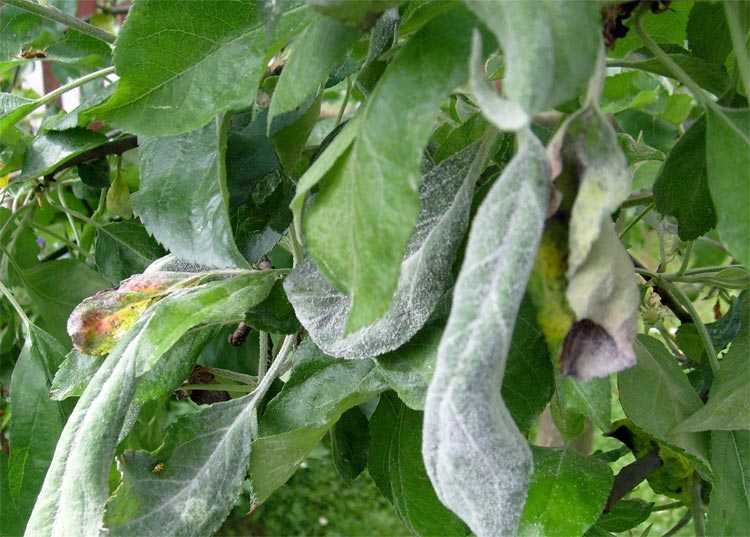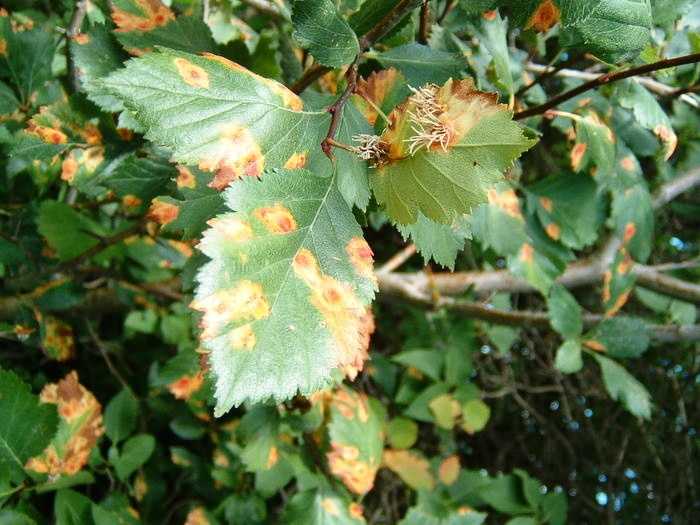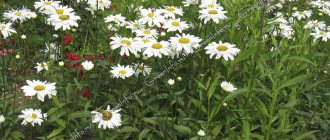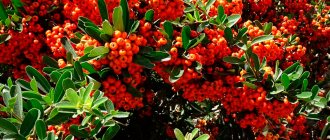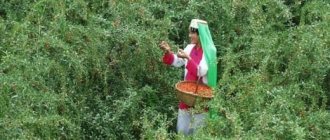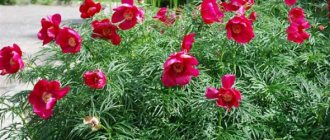- Pinching
- Seed cultivation
- By cuttings
- Lignified cuttings
- Root offspring
- Layers
- Conclusion
There are several ways to propagate quince yourself. The choice of method is influenced by the time of the procedure, climatic conditions and the type of plant. Also important is the care for the plants after planting, on which the future harvest and the health of the cultivated trees will depend.
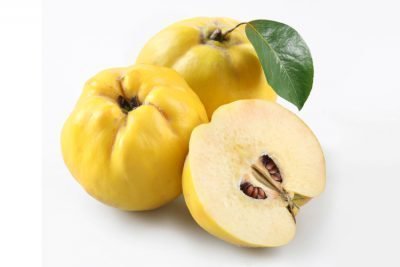
Seeds for propagation of quince should be taken only from a ripe fruit
General description of the culture
Quince is a heat-loving plant that takes root better in the southern regions of the country, but depending on the qualities of the variety, you can plant a tree in northern frosts. Quince reaches a height of 3 to 5 m in the form of a tree or is presented as an ornamental shrub that grows up to 1 m in height and grows up to 2 m in width.
The plant bears fruit in September or October, depending on weather conditions and variety. Fruits have a lot of useful properties and are widely used in the food industry, are part of medicinal ointments and preparations.
Description of an ornamental shrub, use in landscape design
Japanese quince is a low-growing ornamental shrub. She will decorate any garden in spring, when many huge (for its small stature) orange-red flowers with a diameter of up to 4 cm, which are strewn with all the branches, are blooming on it.
In summer, the plant attracts the eye with its glossy foliage with pouring fruits. In autumn, it is strewn with medium-sized yellow fruitsresembling small apples.
Gardeners mainly plant low shrubs for decorative purposes. A group of 3-5 plants looks very good on lawns. A small bush of quince will decorate a flower bed or an alpine slide, often used in landscape design.
Shrub blooms in May and, due to the uneven opening of the buds, the bright bloom stretches for 2-3 weeks.
Spireas, forsythia and magonia will become worthy partners in garden compositions for her.
Quince has the ability to grow in breadth due to abundant root growth, and this is its quality very often used to strengthen slopes (it holds the soil).
You need to be careful with shrubs, as there are sharp thorns on some varieties.
Henomeles (Japanese quince) due to its frost resistance (it withstands frosts down to -25 ° well) suitable for growing in the Moscow region... With frosts below -30 ° C, the buds may freeze, but the bush will not die.
With proper cultivation, the shrub grows up to 40 years.
Japanese quince, or chaenomeles:
Breeding with bones
Seed quince is a bit of a laborious process, but if you follow the rules and show perseverance, you will soon have strong sprouts ready to plant.
The choice of planting material
In order to germinate seeds on your own at home, you should choose the right material for planting. The best way to select seeds is to pick the most beautiful fruit from the tree. The fruit should be large, free from rot, disease or damage from pests. To get the seeds, you need to cut the fruit and carefully poke out the planting material.
The seeds are laid out on a newspaper and dried in the sun for a day. Dried bones are assessed visually: for chips, damage, infections.
Sprouting from seed
How to grow a quince from seeds at home in order to get healthy shoots: you just need to stratify the planting material. The concept of stratification should be understood as the natural selection process that each seed goes through if it germinates in natural conditions. At home, you need to create a cold, humid atmosphere for the quince seeds to sprout.
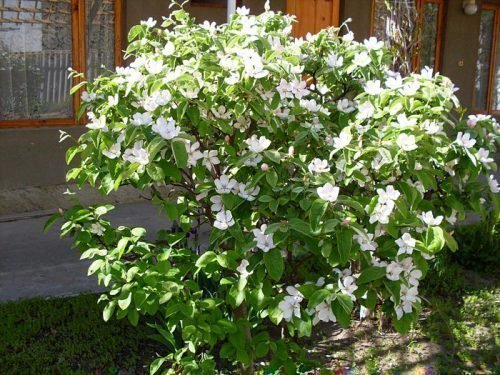

First, all seeds must be soaked in water at room temperature for 4 days, avoiding stagnation of the liquid. The water should be changed every 12 hours. Then they begin the process of stratification.
- Prepare a container for sprouting the material - it can be an airtight bag or a pot that will need cling film to make the container airtight.
- The choice of the substrate in which the seeds will be stored for 2-3 months: fine wood shavings, soil, coarse sand.
- The soil is moistened with a spray bottle, 2-3 sprays are enough.
- In order to prevent the formation of mold spores, the fungicide "Oxyquinoline" is used, which is introduced into the substrate together with the seeds.
Harvesting in autumn, storing fruits
Quince fruits are small, hard and sour in taste, but very aromatic and with a high content of vitamin C. They are harvested in September - October, before the onset of frost.
They are stored at an air temperature of 1-2 ° C for 2-3 months. As a result of maturation, they become softer, the sweet aroma is enhanced.
The easiest way is to cut the quince fruits into slices or grate, sprinkle with sugar in a 1: 1 ratio and store in the refrigerator. This blank is used in the preparation of drinks and added to tea.
Jams, jams are also made from the fruits of chaenomelis, and added to compotes. Due to the high iron content, chopped fruits darken quickly.
Japanese quince. Northern lemon:
Landing rules
To plant quince seeds, it is required to determine at what time of the year it is best to plant the plant in open ground. The germination and development of a planted tree is influenced by weather conditions, humidity, and climate features. Cultivation from seed is carried out in summer, autumn and spring.
To properly plant a quince, the following conditions must be met:
- planting is carried out only at a distance of 3.5 m from adult trees;
- the site must be well lit;
- the absence of drafts is desirable;
- the high occurrence of groundwater does not interfere with the growth of quince, but it is still better to plant it in an area where the water is at a minimum depth of 1.5 m.
Planting in the summer
Planting in the summer doesn't take a lot of effort. Planting material, harvested in the fall, should be selected and disinfected in a weak solution of manganese. Within 3 days, the seeds will undergo a disinfecting treatment and will be prepared for planting in open ground.
For planting, a small trench is dug with a depression of 10-15 cm. The seeds are sown at a distance of 3-5 cm from each other and covered with earth. A soil embankment is required along the edges of the trench to facilitate watering.
Planting in autumn
You can plant quince in the autumn. For this, freshly picked fruits are taken, from which the best seeds are selected. Place the planting material according to the same principle as in the summer, only without preliminary soaking.
In mid-November, it is required to cover the hole with sawdust, fallen leaves, in order to keep the bones from frost. During the spring thaw, remove a layer of foliage and sawdust so that the sprouts can break through the soil.
Why are fruit trees pruned?
Fruit trees, including quince, give a rich harvest if several branches are removed.
- Pruning slows down the growth of the tree.
- Stimulates the growth of generative branches.
- Increases the number of fruits.
- Prolongs plant life.
- Sanitary pruning helps to eliminate possible spread of diseases and pests.
Quince is a light-loving culture, demanding care, and it is necessary to strive to cleanse the inner space of its crown from unnecessary branches.
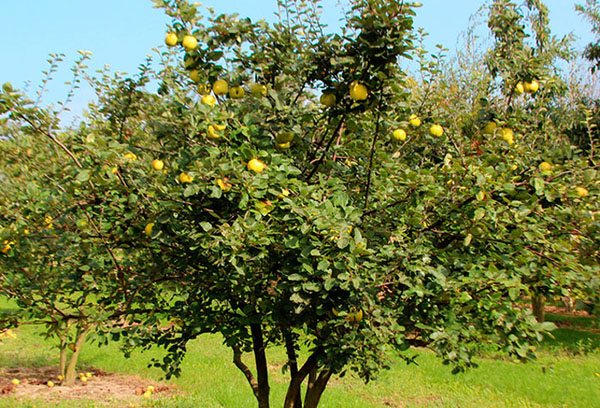

Fruitfulness
In order to get a good harvest after planting from the seed, you need to choose the right quince variety for planting. You should know that if the climatic features do not suit the quince, then it will not sprout or die. The consequence of a poor choice of planting material is low yield, crushing of fruits and loss of taste.
The best choice is varieties with large fruits, late ripening. Sprouts obtained from seeds and rooted in open ground are capable of beginning fruiting at 3-4 years of development. It is imperative to choose the right site for planting and provide the seedlings with moisture, then the harvest will delight you with a huge amount of fruits.
Chaenomeles pruning rules
The shrub tolerates pruning very well, but most gardeners, due to the thorniness of the plant, do not do it in vain. Quince pruning is necessary to improve growth and crown formation for decorative purposes.
There are three types of trimming:
- Sanitary - dry, frozen and broken branches are removed in early spring.
- Formative - they begin to do it from the age of 4, when the branches begin to branch. Shoots growing inside the bush and thickening it are cut out, excess root growth is removed, leaving no more than 2-3 young shoots annually to avoid strong expansion of the bush in breadth. Shoots creeping on the ground are also removed, they take food on themselves and thicken the bush.
- Rejuvenating - it is produced from the age of 8 in the bush, when the annual growth becomes less than 10 cm. Thin and elongated shoots are removed, leaving the strongest 10-12 in the bush. When thinning, it must be remembered that the most productive are shoots at the age of 3-4 years, older branches must be removed.
In order to avoid the penetration of diseases into the plant, all sections must be treated with garden varnish.
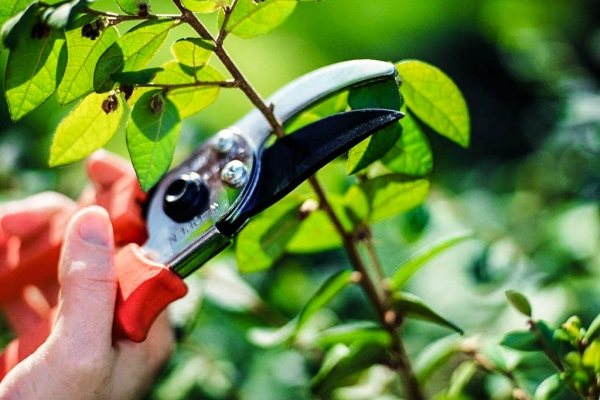

Quince pruning is necessary to improve growth and crown formation for decorative purposes.
Care features
Care should be timely: as the soil dries up, watering is required, it is carried out without too much enthusiasm, so as not to flood the plant and not lead to the formation of rot. For the winter period, newly planted shoots should be sheltered from frost, and released with the arrival of spring.
Pruning of the plant is carried out after reaching a growth of 1 m, all vigorous, thin shoots are cut out. At the rate of intensive growth, organic fertilizers are applied with a frequency of once every 1.5 months.
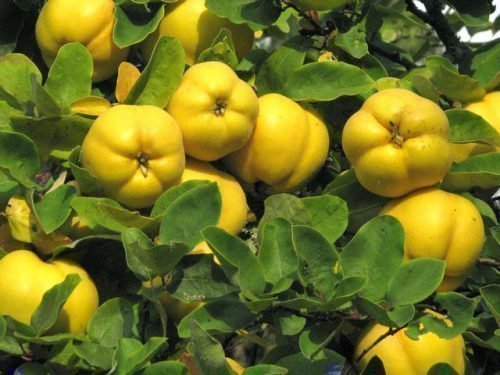

When is the best time to prune trees?
Quince recovers quickly. In the spring, dormant buds wake up on the roots and on old wood. These shoots will completely renew the crown in a few years.
- Spring is the best time for pruning quince. The most suitable period is from late March to early April. You cannot cut it later: sap flow begins, and the liquid will not allow the cuts to heal quickly - the tree may weaken. In addition, an easy way opens up for the penetration of pests and pathogens.
- In the fall, when the tree sheds its leaves, sanitary pruning is required. Quince is freed from damaged or dried branches, in which pests can overwinter. All branches are carefully examined to remove diseased ones. The cuts are made on healthy wood.
- In winter, quince branches become very fragile, wounds do not heal well. Therefore, pruning is contraindicated.
The cuts are cleaned of irregularities, a layer of garden varnish is applied to them or carefully painted over. There is also an opinion that wounds should heal on their own, without treatment.
Advice
At the end of summer, vigorous shoots are determined and their tops are pinched.
Seed selection
For planting, you need a dozen seeds - this is in case some of them do not germinate, although their germination rate is high - about 60-70%.
Use only ripe fruits without damage or rot. In such fruits, the seeds will be ripe and of high quality. Select seeds that are firm and free of mold or damage.
Seed planting is carried out in the autumn, when the fruits ripen (September - October). You can plant seeds even after the first snow falls. Already in early spring, you will notice how the seedlings will appear together.
You can plant seeds in the spring, but you will not be able to see the first shoots earlier than in three months. Therefore, many gardeners prefer autumn sowing.
Root offspring
This method does not always make it possible to get a good plant. Usually, a stunted tree grows from such planting material, which bears fruit in small fruits.
How dwarf and garden quince reproduces with the help of root suckers correctly:
- if your tree has root shoots with a diameter of about 5 mm and a length of up to 20 cm, they should be tucked higher so that the soil fits snugly against the branch;
- after 3 weeks, the hilling procedure must be repeated;
- then separate the shoots from the mother plant so that each specimen has roots.
Young seedlings are planted in fertile, slightly acidic soil. After planting, the plants are spilled with water, mulched with peat or humus.
Stratification
To grow a strong and healthy tree, it is necessary to properly prepare the planting material. The seeds are subjected to stratification (hardening). They are placed in a humid environment at a low temperature. Alternatively, you can put the seeds in a cloth bag and bury them in damp earth. This stratification is carried out during autumn planting. Within a couple of weeks, they will be ready for sowing.
Seeds can also undergo stratification at home in December, if spring planting is planned. A layer of sand is poured onto the bottom of the pot, then the seeds are laid out on its surface, sprinkled with sand again and so done to the very top. Seeds in the sand are watered abundantly, wrapped together with a container in a plastic bag and placed in a basement or refrigerator. The temperature of keeping future seedlings should be within 0-5 ° C. The term for stratification is 2 months.
By cuttings
Reproduction of quince cuttings is the only way that makes it possible to get a new plant with varietal characteristics of the mother tree.
For this growing method, you need annual green shoots.
Cuttings are cut in June in warm sunny weather. Each shoot should have 1-2 internodes and a heel about 1 cm long. Shoots are cut at an angle of 45 °. The place of the cut is dipped for 1 hour in a root formation stimulator ("Heteroauxin", "Epin" or "Kornevin"). Then, the shoot is dipped into a wet substrate of peat and sand (3: 1) at the cut point. The cutting is planted at an angle. With a stable temperature regime in the range of 23-25 ° C, the cuttings take root in 1-1.5 months. The percentage of rooting by cuttings is up to 50%.
After that, young plants are planted on the site for a permanent habitat.
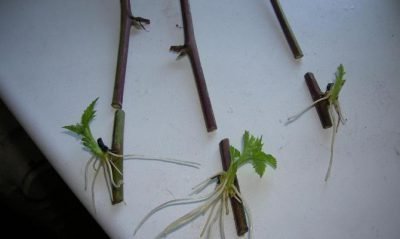

In half of the cases, quince cuttings take root.
Lignified cuttings
You can propagate this plant with one or two year old cuttings. The strongest and healthiest cuttings with lignified bark are chosen from the lower branches on the tree. Cut 20-25 cm long so that the bottom cut is next to the kidney. Cuttings are planted at an angle in the same nutrient mixture as lignified shoots.
Approximately 2-3 weeks before rooting, the lowest bud is sprinkled with nutritious soil by 1-2 cm. Then the substrate is leveled and mulched with peat.
Disembarkation
There are 2 ways to grow quince from seeds: plant stratified seeds directly in open ground in the garden or in seedling containers at home.
In the open field
Seed planting in open ground is carried out at the end of October. February seeds will be ready for planting in the last decade of April or early May.
For full germination, seeds require nutrients. Use an area with humus-rich soil. If the planting takes place on poor land, you can fertilize it with compost or rotted manure. 7-8 kg of the nutrient component is applied per 1 m2 of area. After that, the site is dug up and left for two weeks.
Before planting, the bed is leveled and grooves are pulled out with a depth of about 3-4 cm.
Jam making
For 1 kg of quince you need: 2 kg of sugar and 1.5 cups of water. Wash the quince, dry it, remove seeds and hard white partitions, cut into small wedges.
Put slices in boiling syrup, boil over low heat for 10 minutes, removing the foam, then remove from heat and leave for 12 hours. Boil the jam again for 10 minutes, etc. until the quince slices become transparent.
We lay out the finished jam in sterilized jars, leave it until winter. In winter, aromatic jam will remind you of the beauty of flowering shrubs and the approaching warm summer.
Japanese quince is unpretentious in cultivation, it is undemanding in attention and easy to care for, but at the same time it is beautiful in flowering and useful in application.
Care rules
It is important not only to know how to grow quince from seeds, but also what kind of young plants need care. The growth, development and fruiting of young trees will depend on this.
Watering
Quince is a moisture-loving culture, therefore, during the cultivation process, it should be watered regularly and abundantly. For the entire season, the plant must be watered at least 5 times.
The first moistening is carried out in early spring - before the buds begin to swell, then during the flowering period and two weeks after the tree has faded. Water the plants during the formation of ovaries and during the ripening of fruits.
Trees are watered abundantly in late autumn - a month before the onset of frost. By this time, they will have thrown off the foliage. Such water-charging irrigation saturates the roots and crown of the tree with moisture, and provides it with good winter hardiness.
Pruning
Starting from the moment of planting, one of the main tasks of the gardener is the formation of the crown of the quince. Usually such a fruit tree is given a sparse-tiered crown:
- In the first year of life, immediately after planting, the central branch is pruned to a third of its length in order to stimulate the growth and development of the lateral branches.
- The next year, the central conductor is cut by 20 cm and the most developmental shoots (3-4 pcs.), Located at a distance of 20 cm from each other, are selected, the rest are cut off. The branches should have an angle of inclination of 40-45 ° С. Since shoots growing at an acute angle will break off under the weight of the fruits. Above the branches of the lower order, 5-6 more branches are left to form the upper tier.
- After crown formation, young trees are moderately shortened annually to stimulate subsequent branching. In fruiting trees, the crown is thinned out, leaving the growths intact.
- Rejuvenating pruning is carried out on older trees and on low-yielding specimens. All branches are cut to a length of 20 cm, which stimulates the development of young shoots.
Top dressing
In the first years of life, young plants planted in fertile soil do not need nutrition. In the third year, the soil around the trunk circle is sprinkled with rotted manure or compost. Then digging is carried out. For the entire growing season, organic matter is applied twice - at the beginning of spring and in autumn - after leaf fall.
Whitewashing the trunk will protect the tree from pests
Mineral fertilizers are applied during the flowering period and the formation of ovaries. For this purpose, superphosphate and potassium salt are used.
Loosening and mulch
Seed-grown quince loves to grow in loose and moisture-permeable soil. Therefore, in the first years of life, a soil loosening procedure is carried out for plants.
Considering that this plant has a shallow and well-developed root system, it is not worth loosing the soil too deep so as not to damage the delicate roots.
Mulching is carried out both to nourish the roots and to protect young seedlings during the winter cold. I use peat, fallen leaves or spruce branches as mulch.
Additionally, young plants growing in the northern zone or in the regions of the middle lane are covered with cardboard or wooden boxes, lutrasil or roofing material.
Prevention of diseases and pests
During the growth process, young plants are especially susceptible to diseases and pests. Therefore, for the purpose of prevention, spring and autumn treatment of crowns with fungicides and insecticides is carried out. In autumn, the trunks are treated with slaked lime.
Outdoor planting and care
Quince is not demanding on growing conditions, but there are several conditions that must be taken into account when planting a seedling:
- the planting site should be sunny, since the shrub grows and blooms poorly in shade;
- in order to avoid freezing of the bushes in severe winters, plant them in places protected from northern winds;
- the acidity of the soil should not exceed 6.5pH (slightly acidic);
- having a taproot deeply going into the soil, the plant does not tolerate transplanting from place to place, we plant immediately and forever;
- the distance between the bushes is 1-1.5 m, when forming a hedge 0.8-1 m.
It is preferable to plant quince in the spring; during autumn planting, the plant may not have time to take root and freeze.
Landing rules:
- pour about a bucket of humus with wood ash (0.5 kg) and superphosphate (0.3 kg) added into the dug planting hole (60 * 60 * 50cm), mix with a shovel with a small amount of earth;
- we place the seedling in the hole in such a way that the root collar was at the level of the soil;
- we cover the roots of the plant with earth and water it well;
- it is advisable to mulch the soil around the bushes (sawdust, crushed tree bark, peat).
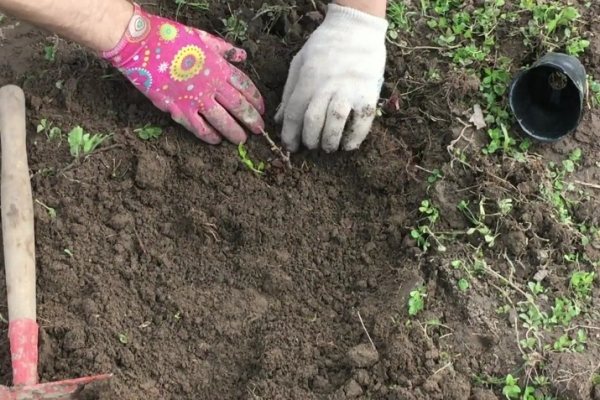

It is preferable to plant quince in spring; during autumn planting, the plant may not have time to take root and freeze
Further care for a young seedling consists of watering, but waterlogging of the soil should not be allowed in order to avoid rotting of the roots, regular loosening of the soil around the bushes.
Since during planting all the necessary batteries were introduced, then no need to feed the plant for two years after planting.
Adult plants in the spring, after the snow melts, are fed with ammonium nitrate about 20 g per bush. In the summer, they give liquid fertilizing with organic matter (diluted mullein or bird droppings). Superphosphate is introduced in the fall.
The plant is winter-hardy, but young seedlings in the conditions of the Moscow region for the winter in the first years after planting are better to insulate.
To do this, you can use spruce branches or cover small plants with covering material (spandbond or lutrasil), put wooden or plastic boxes on top and sprinkle with fallen leaves.
Quince fruiting annually, starting from the third year after planting.
Chaenomeles cross-pollinated plant, therefore, for better pollination and increase yields, 2-3 bushes need to be planted nearby.
Features of planting chaenomeles:
Features of using quince
Japanese quince is an amazing plant with a lot of useful qualities, therefore it has a wide range of applications:
- Food use. Many delicious dishes are prepared from aromatic fruits. Dry powder is an excellent substitute for flavoring for dough. Juice, jam, liqueur are no less tasty.


- Decorative application. Japanese quince is so beautiful at any time of the year that landscape designers could not help but pay attention to it.Plants can be placed individually or in group plantings. Hedges look great during flowering.
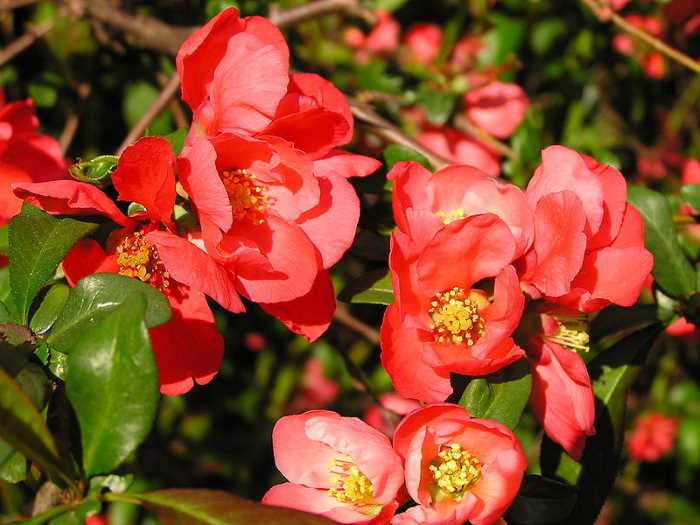

- Medical applications. The fruits have a tonic effect, can increase mental physical performance. The juice has a beneficial effect on the blood, strengthens blood vessels, and counteracts the development of atherosclerosis and inflammatory processes. Quince and its juice are recommended to eliminate anemia, colitis and diarrhea.
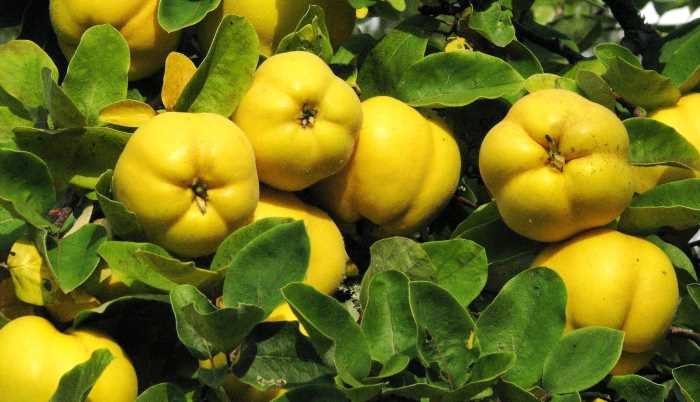

How to propagate by layering
In spring, long lodging shoots are pinned to the ground and covered with earth. During the summer, these places are often watered and additionally hilled. The next spring, plants sprouted in this way can be planted. To do this, they are cut off from the mother bush with a shovel or garden shears.
A soil mixed with humus and mineral fertilizers is poured into the prepared hole, corresponding to the size of the roots. They immerse the seedling, straighten the roots and carefully sprinkle them with earth. Condensed and watered. In the future, they are looked after as for other garden plants.
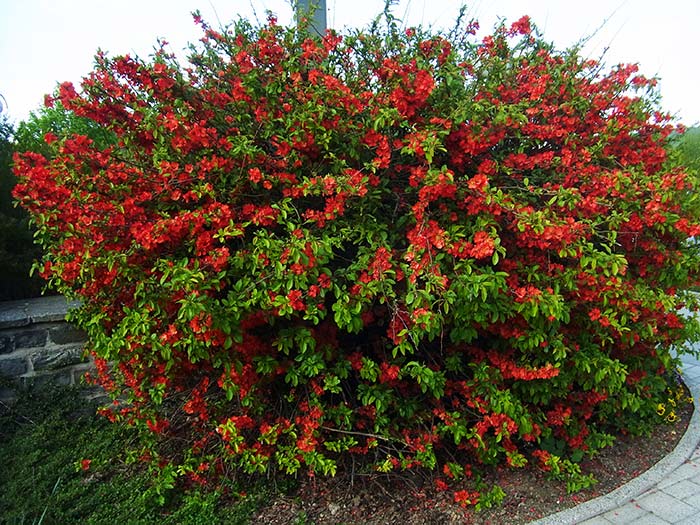

Japanese quince is great for creating a hedge
Reproduction methods
Japanese quince, unlike many seed fruit crops, can be propagated using:
- seeds;
- cuttings;
- layering;
- root suckers;
- dividing the bush.
The most common and easiest way is to grow by seed. How to grow quince from seeds at home, how to care for plantings, will be discussed further.
Video: reproduction of quince
Growing from seeds
Getting seed at home is easy. You just need to choose well-ripe fruits. The seeds should be full, dark brown in color. They are dried and put into a linen bag.
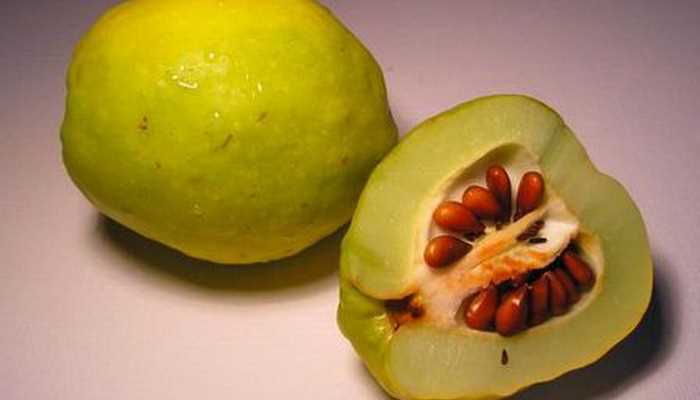

In order for the seeds to hatch, it is necessary to carry out stratification. This procedure will vary based on the sowing time:
- When planting seeds in the fall, they are immediately placed in the ground, sprinkled with earth until spring. In this case, stratification takes place in a natural way.
- If sowing seeds is planned in spring, then 3 months before planting, the seeds are soaked in warm water and placed in a slightly moistened substrate. Then put it in the refrigerator on the bottom shelf.
Video: preparing quince seeds for sowing
Seeds are sown in February in separate containers so as not to damage the thin root system. After the appearance of 2-3 true leaves, the seedlings dive into a large container.
Pests and diseases
Chaenomeles is not damaged by pests and has great resistance to diseases, but in cool and rainy summers such diseases as:
- leaf necrosis - the appearance of a gray bloom along the edge of the leaf with further spread over the entire surface of the leaf, the leaves dry out;
- cercosporia - manifests itself in the form of dark brown round spots that brighten over time;
- ramulariasis - the formation of brown spots on the leaves.
To combat diseases, spraying of shrubs with solutions of copper sulfate (10% concentration) or a solution of foundationol (concentration 0.2%) works effectively.
Is it possible to share a bush
Actually, the bush itself cannot be divided, but the germination of root shoots is characteristic of chaenomeles. Due to this, the bush spreads. About 5-6 shoots can be planted from one quince. The strongest seedlings are selected and separated from the bush.
Advice. It is best to plant root shoots in spring. In warm weather, they take root better in a new place.
Despite its simplicity, the method has significant drawbacks:
- Many offspring do not develop the root system well, which does not allow them to quickly take root.
- At the first harvests on bushes grown in this way, the fruits are smaller than usual.
Japanese quince is a versatile plant. It is good both in single plantings, and in group, and as a low hedge. Extraordinarily aromatic jams and compotes are prepared from its fruits, they are used as aromatic additives for hot drinks and as a seasoning for meat dishes.Considering all the advantages, it is advisable to plant more than one bush in the garden. Anyone, even an inexperienced gardener, can propagate a shrub.
Purpose of pruning fruit trees
The purpose for which pruning is carried out depends on the selected time of the season. These aspects of the procedure are closely related.


- In the spring, they carry out key procedures for crown formation. By pruning, the desired growth vector is set, the nature of fruiting is determined, and its volume is controlled. The beginning of the season is the optimal period for the procedure, since the vegetative processes have not yet begun in the plant and there are several favorable months ahead for recovery.
- In the summer, a partial adjustment is made. Brush branches that over-thicken the crown.
- In the fall, the sanitary problem is solved. At this time of the year, the procedure is needed to remove diseased, old, damaged and infertile branches. It allows the tree to better prepare for wintering, and reduces the likelihood of developing diseases. The risk of pruning quince in autumn is the proximity of wintering. The tree, having received damage, often does not have time to recover, and the weakening before winter increases the risk of death.
How to properly grow Japanese quince
A well-lit area is best suited for a plant. Japanese quince is highly desirable as much sunlight and heat as possible. In shaded areas, the quince is not comfortable, it grows poorly, develops poorly and, of course, this is reflected in the number of ovaries and fruiting.
As for the soil, light sandy loam or loamy soil will be an ideal option for Japanese quince, soddy-podzolic soils, with a large amount of humus and a weak acid reaction, are well suited. Peaty and alkaline lands are undesirable for Japanese quince, since chlorosis can occur on plants living in such conditions.
Soil preparation
If you choose a site where there are no drafts and strong winds, the quince will be extremely grateful to you. Cold and frost have an extremely negative effect on this lover of heat.
Prepare the site in the fall. To do this, you need to dig up the area and select all the weeds, as well as make the soil fertile. The following is carried into the soil: sand, leafy soil, compost based on peat and manure, potash and phosphorus additives.
All ingredients mix well and leave until spring. By this time, the earth will absorb the maximum of useful substances and will be completely ready for planting Japanese quince.
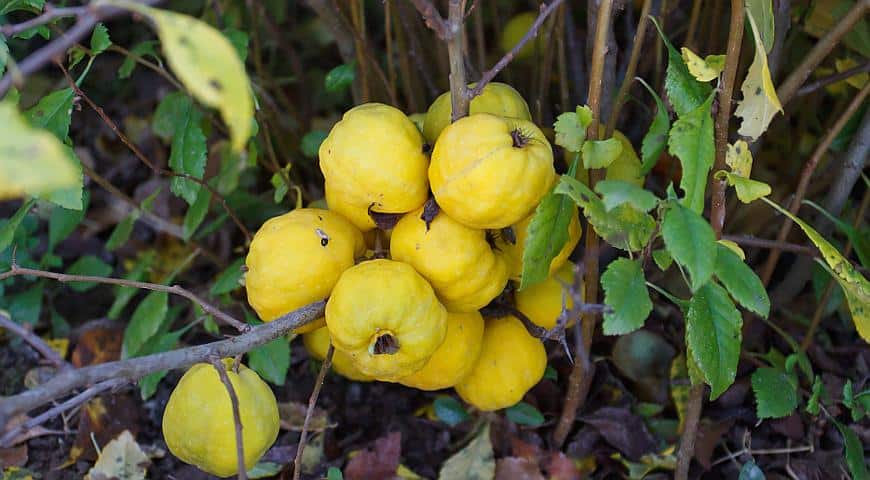

Planting a plant
It is best to plant two-year-old quince seedlings in a permanent place. It is possible to buy a plant from a nursery, but many growers successfully grow their specimens.
During planting, make sure that the horses of the quince are not bare, and the root collar is above the soil level. It is extremely difficult to endure a quince transplant, therefore it is important to decide once and for all on a permanent place.
When planting several plants, it is necessary to adhere to the honey seedlings distance. It should correspond to 1 m. Then the group planting will soon become a real hedge, and the plants will not interfere with each other.
Mulching
Mulch for each type of plant is a reliable protection against weeds, insects, it helps to maintain soil moisture and prevents the root system from drying out. In the summer, especially during the hot season, mulching helps to save the plant from overheating.
Sawdust, crushed bark, sawdust, peat are suitable for mulch. They need to be poured around the plant in a layer of 5 cm. It is good if the diameter of the mulching matches the bush. It is necessary to start the process in the spring and try not to forget to throw mulch throughout the summer.
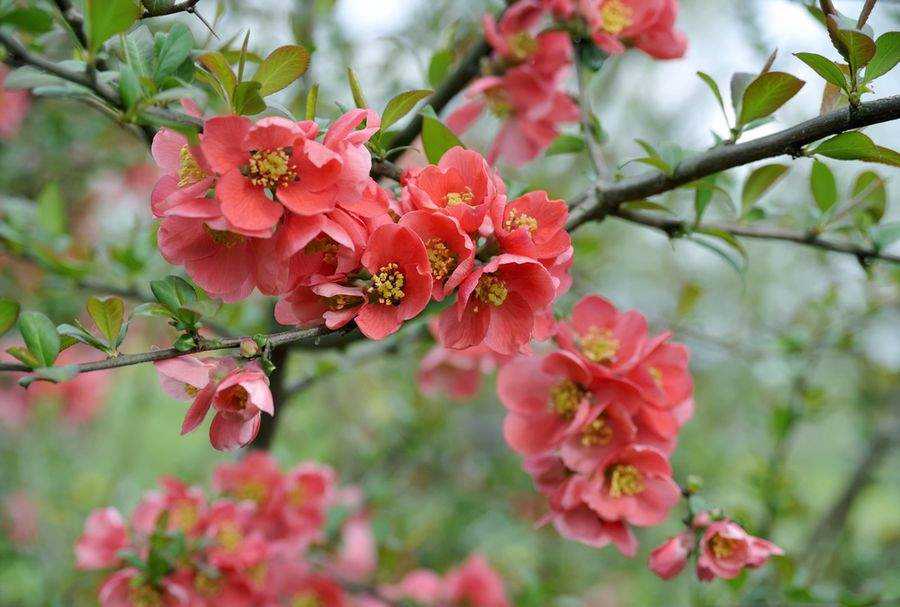

Pruning
In order to avoid strong sprouting of shoots and the bushes do not look sloppy, Japanese quince should be formed. But, and strong shortening should not be done, since the crown begins to quickly and vigorously throw out new shoots, which leads to overgrowing of the bush.
The optimal shortening is to trim the shoots one third of their length. Of course, when pruning, all broken or damaged branches, broken and weak shoots are removed. During the first five years, pruning for rejuvenating quince is carried out every year in the spring, and for subsequent years the gardener carries out an execution depending on the condition of the bushes.
You can not do pruning in the fall, young twigs may not have time to get stronger and they will be damaged by sudden frosts. Due to an event such as pruning in the fall, gardeners often lose their plants entirely.
Consider one more point, in the first years of life, the Japanese quince will need support, since the shoots often develop unevenly. As soon as the bush begins to bear fruit, it will be possible to form it completely, and remove the support.
Moisturizing
There is a special watering regime for Japanese quince. It should be taken very seriously, since the plant does not like frequent moisture. There should be no more than six watering sessions in total.
- In the spring before the blooming flowers
- During flowering
- After the ovaries have fallen off, when the flowers are dropped
- During the growth of young shoots
- One month after the last watering
- During the formation of fruits and their growth.
Each bush will require at least 400 liters of water, such a large amount is explained by the deep bedding of the plant roots. Young roots go into the soil to a depth of 80 cm, the root system of an adult bush is up to a meter deep.


Top dressing
Nutritional supplements for quince are added throughout the growing season
- In the spring, mineral and organic fertilizers should be applied;
- In summer, plants especially need support with nitrogen, phosphorus and potassium;
- In the fall, organics and minerals should be demolished again, they will help the quince to winter safely.
Do not bother with top dressing in the first year after planting, because during the preparation of the soil, a sufficient number of various nutritional supplements were introduced. Youngsters will have enough of them until next season.
Reproduction
There are several ways to propagate Japanese quince: seeds, cuttings and root suckers. Let's get to know each of them separately.
- The seed reproduction method is the simplest and most effective, albeit a little time-consuming. You will need seeds that are cleaned after the fruits are fully ripe from the core. The seeds should be dried and sown directly into the soil before winter. In the spring you will see young shoots, while it does not matter at all in what soil the seed was placed.
- Cuttings are harvested in early June, in the morning. Each branch should have a pair of internodes with last year's wood. For the effectiveness of the event, the cuttings are placed in a root-forming preparation, then in a soil consisting of peat and river sand in proportions 1X3. The plantings are covered with a film and kept for 1.5 months at a temperature of at least +23 degrees.
- It is a pleasure to propagate quince using root shoots. However, you should be aware that this method has one significant drawback: the first fruits that the bush that has taken root from the shoot will give will be small, and not yet fragrant.
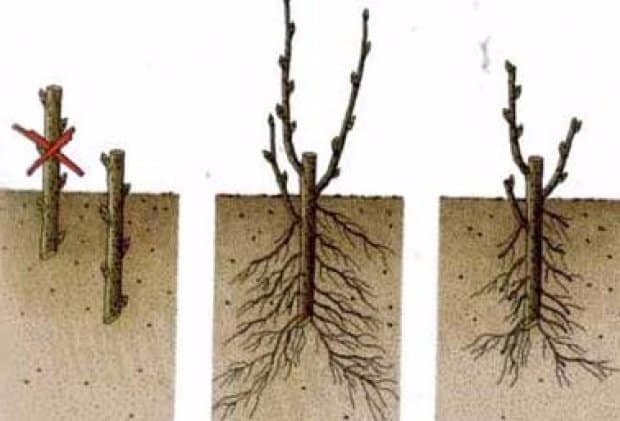

Diseases and harmful insects
In order for the plant not to get sick with fungal diseases, necrosis, it is sprayed with a solution of copper sulfate prepared according to the instructions. Among the folk methods, one can single out a prophylactic agent consisting of water and onion husks, which is infused for several days before spraying.
Various chemicals sold in specialized stores are used against pests, these are Fufanol, Inta-Vir, Zircon and many others.
Common varieties
To date, breeders have created a huge number of varieties, but the most popular are:
- Oil early, characterized by early ripening;
- Muscat, distinguished by a delicate aroma;
- Aurora, highly resistant to adverse climatic conditions;
- Anzherskaya, the fruits of which are used for processing and can be consumed fresh;
- Golden: the yield is more than 40 kg per tree;
- Kaunchi-10, characterized by sweetish fruits that can be used fresh.
The scrupulous work of breeders allows gardeners today to enjoy fresh fruits, prepare dishes of an amazing aroma, compotes, baked goods.
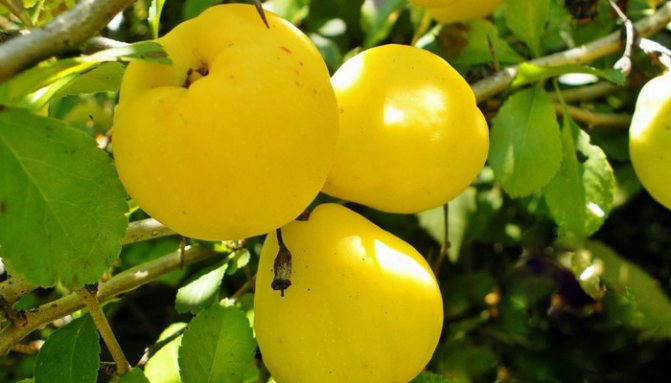

Reproduction of Japanese quince, planting care for it: photo
Last summer I was able to visit my friend, who treated me to an amazing fruit, adding it to tea.
Its sour taste reminded me very much of lemon, but the interesting taste and aroma of tea was obtained from Japanese quince. Having become interested in this amazing fruit, I asked the hospitable hostess to talk about the value of this culture, and she told me the following about the Japanese quince.
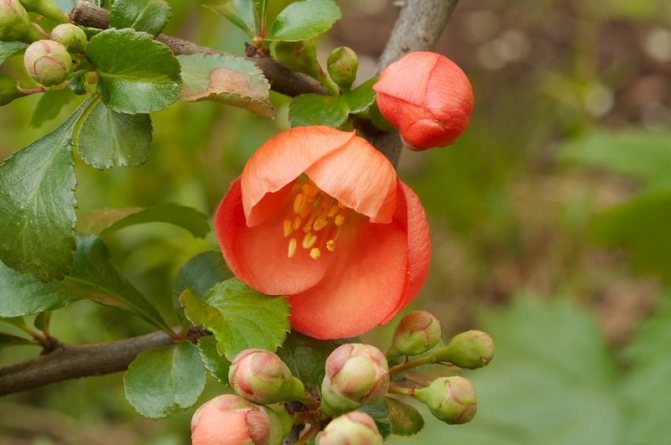

Variety differences and features
In total, there are five main groups of this plant. All of them differ not only in height, volume of a bush or tree, but also in the shape of the fruit.
In apple quince, they are very reminiscent of apples, in Portuguese or pear quince there is a similarity to pears, in marble quince fruits with yellow and white spots, in pyramidal quince the main difference is in the leaves, they have the shape of a pyramid.
Among the most popular varieties are the following: Quince "Aurora", "Anzherskaya", "Anzherskaya from Gorin", "Buinakskaya large-fruited", "Vraniska Denmark", "Golden", "Gold of the Scythians", "Golden ball", "Butter late "," Early butter "," Muscat "," Early ripening "," Japanese Henomeles "or" Japanese quince ".
The last representative will be discussed today.
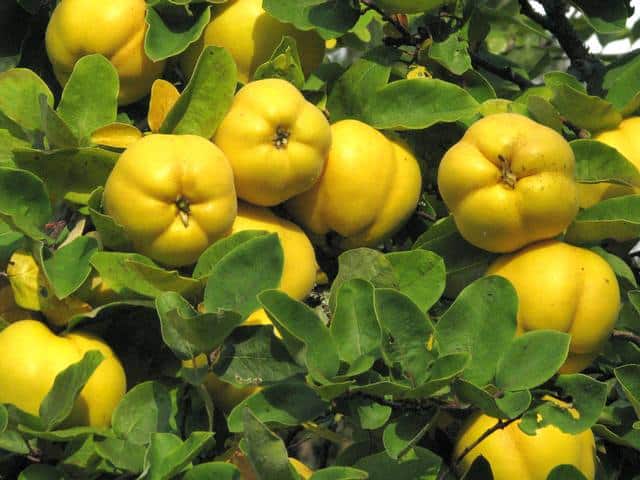

Pruning old branches for new growth
In order for the Japanese quince not to get sick, you must not skip leaving in the fall. Pruning branches is the best preparation for winter. To do this, you need to get a pruner, sharp garden shears and heavy gloves. If you work with your bare hands, you can get injured by thorns.
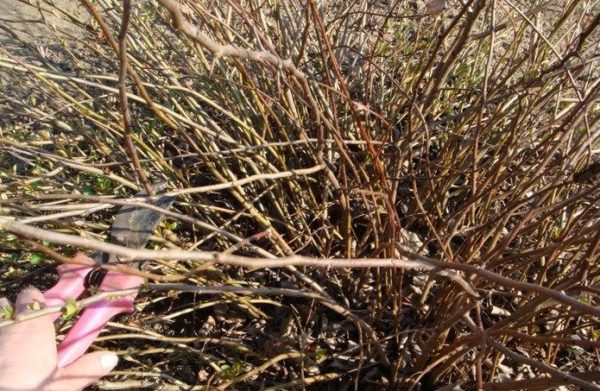

First of all, you need to correct the shape of the bushes and cut off the old branches, which can be distinguished by the darker bark. Together with them, we confidently cut off broken and starting to dry out branches, as well as young shoots protruding strongly forward, shortening by about ⅓ part.
The shrub after pruning should resemble an oval shape. With the first frosts, it freezes a little and will remain in this form for the whole winter in order to please in the spring with the correct growth.
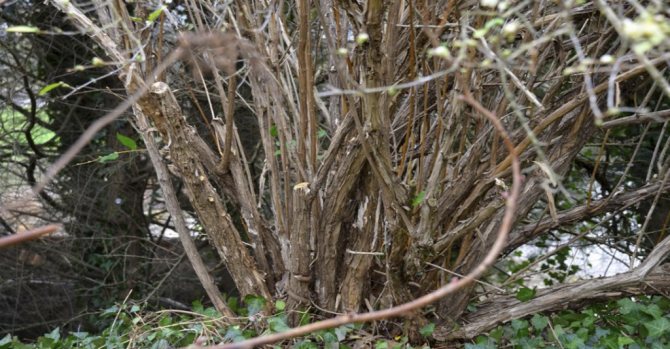

Seeds
Reproduction of quince seeds is the easiest way. The seeds of a ripe fruit are used as planting material. They are extracted from the fruit, the pulp is sent for processing, and the seeds are planted in the soil. The ideal period is autumn, but if it is not possible to plant in this season, then the seeds are stratified.
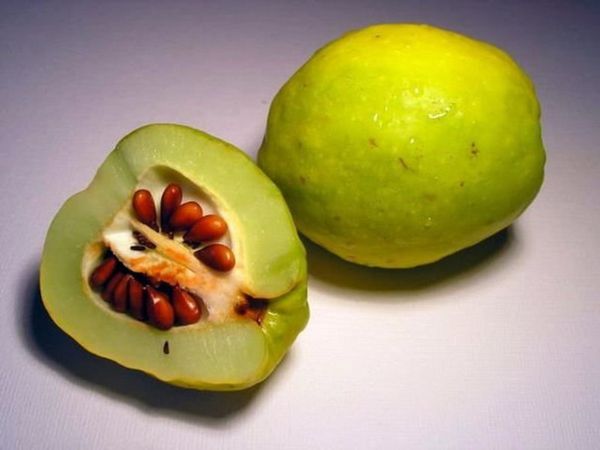

The latter means that it is necessary to create conditions for the seeds close to natural: place the material in wet sand for a couple of months and maintain the ground temperature at 0 ° C. During this time, the seeds open and germinate slightly, after which it is immediately worth transferring them to open ground. Quince is an unpretentious crop, therefore it takes root well in any type of soil.
The advantages of this method are obvious - ease of implementation and a high probability of seed germination.
Fruit properties
Due to its biochemical composition, Japanese quince is recommended for certain diseases. For example, if you are overweight, it is used because of the low calorie content of the fruit, as well as as a means to help strengthen the cardiovascular and nervous system.
During pregnancy, Japanese quince helps to get rid of the symptoms of toxicosis, acts as a diuretic, and is also used to prevent anemia. With colds, due to the high content of vitamins, it helps to strengthen the immune system.Infusion of seeds in folk medicine is used as an expectorant.
With the help of infusions and decoctions from leaves and branches, they strengthen hair, cleanse the skin, and are also used to normalize blood sugar levels. In addition, the fruits do not contain allergens.
However, the properties of quince have a downside. The peel of the fruit negatively affects the condition of the larynx, therefore, those who are especially important for the work of the vocal cords, as well as with diseases of the throat, should not use them without heat treatment. It is also not recommended to use Japanese quince because it suffers from constipation.
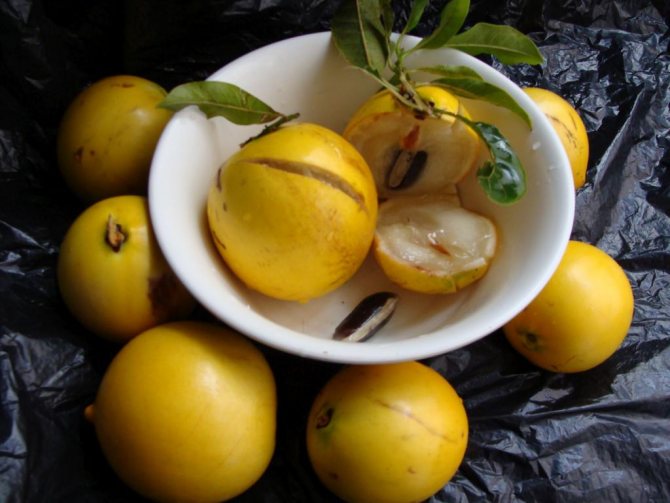

Planting young plants
In order to plant quince in the spring, the soil must be prepared in the fall. All weeds must be carefully removed and the area kept under black steam until planting. If the soil is infertile or heavy, a mixture of two parts of leafy soil and one part of sand should be added to it. It is also recommended to add peat compost, phosphorus and potash fertilizers. The depth to which these components are introduced should be 10-15 cm. Due to this, a loose water and air-permeable soil horizon is created.
The best time to plant a young chaenomeles is after the soil has thawed. However, you need to be in time before the buds begin to bloom. The plant can be planted in the fall, when all the trees begin to shed their foliage. However, there is a danger that when planting at such a time, the heat-loving quince will not have time to take root and will die from the cold.
It is good to plant a biennial plant that was previously in a container and has a closed root system. Such bushes take root and grow better. Single shoots are planted in pits, the diameter of which should not exceed half a meter, the depth of the planting pits is 50-80 cm. They are filled with humus, superphosphate (300 g), potassium nitrate (30 g) or ash (500 g) are added.
When planting a group of plants, the distance between them should be at least one meter.
When planting, the root collar should be at ground level. The root should be completely underground: its exposure occurs if the plant was not planted correctly, and the root collar was above the soil level. If the root collar is below the soil level, this will slow down the growth of the shrub.
The Japanese quince does not tolerate a transplant. and in one place it can grow well for 50-60 years.
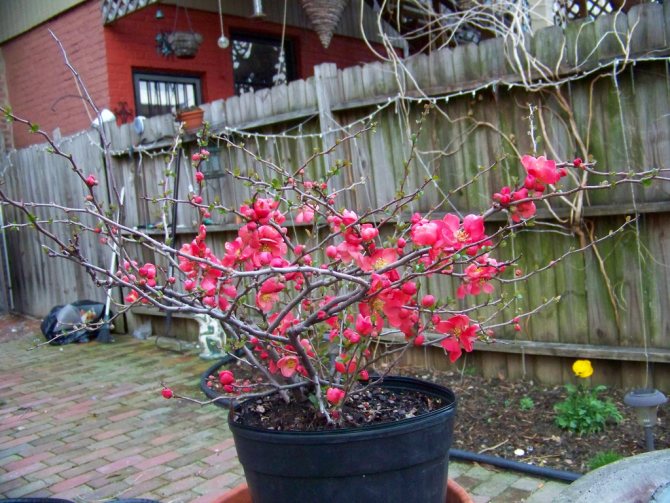

Agrotechnics of common quince
Among fruit and berry crops, oblong quince tolerates insignificant turfing of the soil in the peri-stem circle better than others.
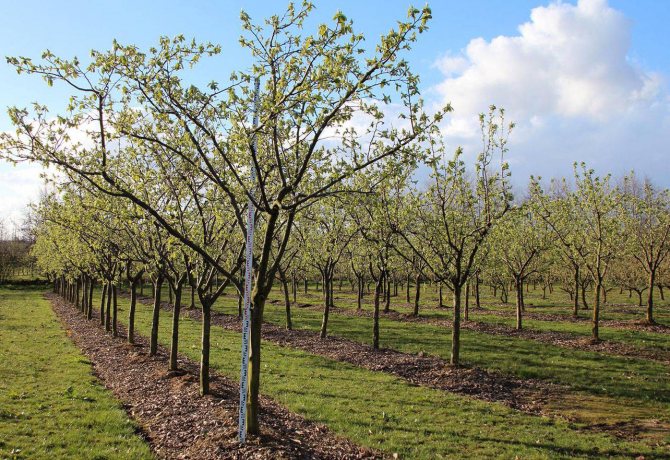

However, it grows and bears fruit worse than if the near-stem space is contained in black steam.
The main processing of the soil is carried out in the fall with digging up the soil to a depth of 15 cm.
During the growing season, the soil is loosened up to 6-7 times to a depth of about 8 cm.
Do I need to water?
With a lack of moisture, quince fruits become smaller, therefore, during the growing season, soil moisture must be maintained at least 65% of the maximum field moisture capacity.
On the eve of the flowering of the common quince, the tree is watered for the first time, then in mid-June and another 2-3 times until mid-September, if the autumn starts dry.
Abundant soil moisture is necessary for the formation of juicy fruits and good growth.
Young non-fertile trees stop watering at the end of summer so that their shoots ripen well.
Top dressing
In the spring, humus is introduced into the periosteal space. As a fertilizer, green manure plants are grown in the near-stem circle.
For prophylaxis against damage by various diseases, in particular, fruit spotting, foliar feeding with microelements is carried out during fruit ovary.
How to properly cut the fruit quince
Pruning is an important element of quince care. Its crown must be shaped so that the branches grow parallel to the soil surface.
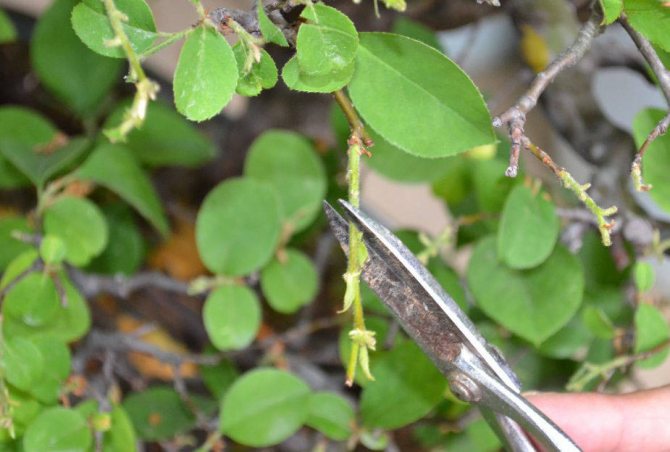

Plants should have a low stem - about 40-50 cm. They are formed in two tiers of skeletal branches.
Annual seedlings are shortened at a height of 70-80 cm from the ground level.
They are not drastically pruned, since this will give a strong uncontrolled growth of shoots, thicken the crown and subsequently delay the onset of fruiting.
In early spring, tops and weak branches sagging to the very ground are removed from an adult tree.
The crown is thinned out as necessary, both weak and strong pagons are removed, and all dry and damaged pagons are cut out during wintering.
For old trees, rejuvenating pruning is periodically performed, which is not much different from pruning apple trees.
What to do and why the quince fruit tree dries
One of the main disadvantages of quince is its susceptibility to damage by many diseases and insect pests characteristic of pome crops.
Perceptible harm to quince orchards is also caused by subcutaneous spotting of fruits, which spoils their presentation and reduces taste.
To prevent this disease, foliar feeding with microelements is used, and in recent years, many varieties resistant to this disease have been developed.
The most common disease is fruit rot or pome fruit moliniosis. As a preventive measure, planting quince is sprayed with fungicides in the proportions indicated by the manufacturer on the package.
On affected trees, diseased branches are removed and burned.
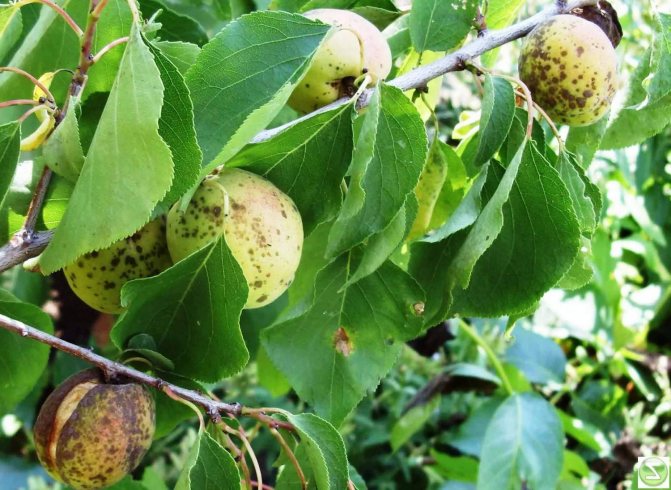

Brown spot of leaves and fruits is the result of fungal spores. Control measures are the same as for fruit rot.
The biggest problem for quince trees is the apple pseudo-bark beetle.
You can fight it only by collecting it by hand.
You can save yourself from the apple moth only by building a mechanical obstacle to penetrate the fruits - gardeners use special paper covers.
The larvae of leaf miner moths develop immunity to many insecticides; biological methods are used in the fight against them, using the natural enemies of the moth - wasp.
Pruning quince in the fall: scheme
During the pruning procedure in the fall season, the most important thing is that the tree must be pruned in such a way as to cause minimal harm to it. There is a certain scheme for this.
In order for the pruning of Japanese quince in the fall to pass safely, and the tree to grow and bear fruit excellently, you need to remember one thing! The more light, the more abundant the harvest will be.
At five years old, Japanese quince should have the following parameters:
- the tree reaches a height of at least 0.6 meters;
- lateral main branches of at least ten pieces;
- the angle between the main branch and the trunk is 45 degrees.
The crown of the quince should be in the form of a bowl. The greenery is evenly spaced so that the light penetrates all the shoots of the tree equally.
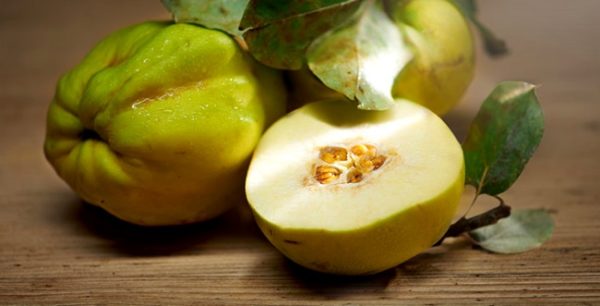

Young quince is pruned regularly. It is at this time that the crown of the tree is formed. After reaching the age of six, the number of trimmings is reduced and carried out only when necessary.
- In the first year of growth, you need to cut the quince in order to form the upper tier of the main branches. The distance between them is seven buds. One tier contains five shoots. They should be directed in different directions, and the distance is about 12 cm. Also, at this age, the second tier of the crown is formed in the tree. The distance between the first and the second is about 40 cm.
- In the second year of life, the branches of the second tier are cut off by 0.5 meters. The main task for the gardener is to form the third tier. Since this is the basis of a mature tree. All branches are pruned 0.5 meters.
Content
- Description
- Planting quince When to plant
- Planting in autumn
- How to plant in spring
- Spring care
- When cut
- How to propagate
Where are ripe fruits used?
Ripe quince is an excellent cosmetic product. Quince pulp is used as masks that have antiseptic and drying properties. Such procedures deeply nourish the skin, saturating it with useful vitamins and microelements. For the preparation of masks, fresh pulp is used, mixed with oil, starch, egg yolk, cereal flour. Quince masks:
- fresh pulp is applied in a small layer on the face, lasting no more than 10 minutes. This is an excellent remedy for oily skin, which eliminates fatigue, helps fight acne in adolescence;
- Mix fruit pulp with egg yolk and oat flour until smooth. The mask is applied to cleansed face and décolleté for 10 minutes. The mask perfectly refreshes combination and normal skin;
- mix quince pulp with oatmeal and cornstarch. The mask is applied to clean skin for 20 minutes and is suitable for all skin types.
Quince lotion is also ideal. It does not contain dyes or harmful substances, and has a very delicate aroma.
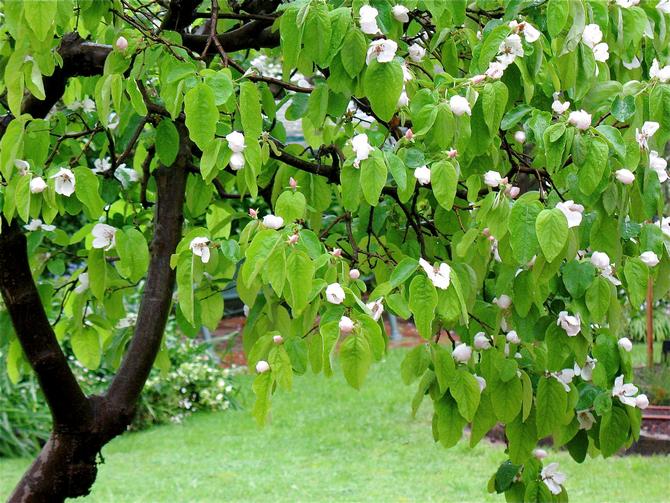

Signs of ripeness of quince
If you want to get the maximum benefit and enjoy the aromatic taste, choose only ripe fruits. You can find out that the quince is ripe by its appearance:
- Ripe fruits have a bright yellow uniform color.
- If you need a crop for long-term storage, choose fruits that do not contain mechanical damage - dents, cracks and blackening. Fruits with an even, smooth and firm skin are excellent for winter storage.
- Use soft fruits for desserts and culinary dishes. They have a pronounced aroma and taste.
- Large Japanese quince fruits are more fragrant than small ones. The presence of green spots on the surface is a sign of unripe fruit.
- The longer the fruits are on the bush, the tastier and more aromatic they become. The main thing is not to overdo it and have time to harvest before the onset of the first frost.
Paper wrapping is one of the most reliable ways to store quince
Planting
The plant tolerates shade well, but for good fruiting it is best to plant it in the sun. You should also think about the convenience of access to plants, since their branches are quite dense. It is better to think over the planting site in advance so that you do not have to move the quince later, since this process is very difficult: the root system diverges very deeply, and when moving, the root parts left in the ground will constantly germinate.
Care and cultivation of Japanese quince does not require too much effort. The plant is easily cultivated in any good soil, can grow well in heavy clay soil. Like most plants, it prefers loam. It can even tolerate swampy soils, but it is not recommended to plant a plant there. Soil with high pH (alkaline) should also be avoided as this can lead to chlorosis.
It is best to plant Japanese quince in a place where there is a lot of sunlight. In shaded areas, it grows poorly and blooms little.
For chaenomeles, light sandy loam, loamy and sod-podzolic soils, rich in humus, are suitable. The plant feels worse on peaty lands.
The most suitable landing site would be an area on the south side or a corner where cold winds do not penetrate. If the terrain is hilly, it is best to locate shrubs on the southern and southwestern slopes.


Cuttings
Reproduction by cuttings is carried out in early summer, when the plant is actively growing. For this, the strongest shoots are cut off and immersed in a solution with a root growth stimulator for a day. Since the survival rate of the cuttings is very low, the use of this solution is a prerequisite. Next, the prepared material is placed in boxes filled with 70% sand and 30% peat, at a slight angle.
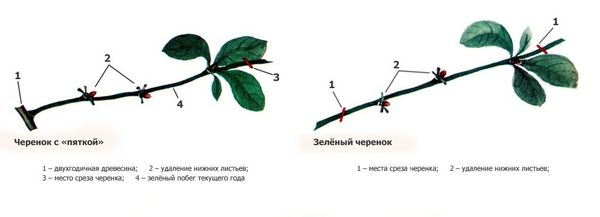

The plant is covered with a transparent material - a cut from a plastic bottle or a plastic bag will work well. Cuttings are kept under an artificial greenhouse until germination. You can understand that the rooting of the quince bush was successful by the presence of new leaves. Then the greenhouse is removed, and at the beginning of autumn the seedlings are transferred to open ground.
Reproduction of quince by this method assumes complete preservation of varietal qualities.
Grafting plants
Spring grafting (improved copulation) is carried out in May: a varietal cutting is grafted onto a Japanese quince seedling. Budding (grafting "with an eye") is carried out with varietal shoots, which are called scion. They must be harvested in the summer, in July or August, at which time the second sap flow begins.
To prepare the scion from the middle part of the varietal shoot, using a special sharp budding knife, the eye (kidney) is separated along with a piece of bark (shield). On the bark of the tree that is going to be grafted (as a stock, you can use an off-grade Japanese quince or another rosaceous plant), you need to make a cut in the shape of the letter T. Then the edges of the cut are folded back, a cut-off peephole with a shield is inserted under the bark. Then everything is pressed tightly and tied. Garden var is used as protection. After three to four weeks, it is necessary to check whether the grafted kidneys have taken root. The next year, in the spring, it is necessary to check whether a new shoot has appeared. In this case, the bandage can be removed.
Two buds are grafted onto the Japanese quince bush at once, placing them opposite each other. Sometimes closely related crops (pear, hawthorn) are inoculated at the same time.
Sometimes a Japanese quince is grafted onto the trunk of a winter-hardy tree below the first skeletal branch. As a basis, a three-year-old wild pear, mountain ash, spicate, hawthorn are used. Since the varietal Japanese quince does not always tolerate winter well, it is better to graft the plant closer to the ground, at a height of 0.6-0.9 m, this will help protect it during the winter cold.
After the grafted shoots have taken root, every season it is necessary to prune the Japanese quince and form the crown of the plant, and from the trunk below the grafting site, it is necessary to regularly get rid of wild growth. To give more stability, the trunk can be tied to a support. Long shoots that develop after grafting also need support. It should be remembered that after grafting on a tree trunk, such plants do not tolerate winter well, it is best to plant them in a place protected from cold and wind, be sure to cover for the winter.
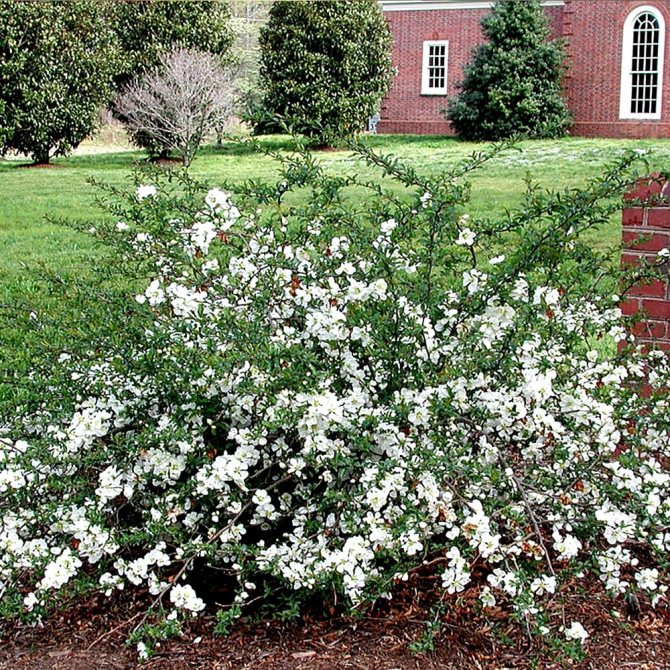

Gardeners reviews
Japanese quince is a perennial shrub with edible fruits. It grows very quickly, but takes root very badly. When transplanting or planting a purchased plant, try to disturb the root system as little as possible. Quince in bloom is very beautiful. Flowers of pale orange color sometimes turn into red. When flowering, the bush seems to be on fire. Flowering is short, but since the flowers do not open all at once, you will have the opportunity to enjoy the beauty for about ten days. The fruits of this shrub resemble a real quince in shape, only in miniature. Fruits are dense, smooth. It tastes very sour. Quince ripens by the end of autumn. The fruits are practically not affected by pests and do not fall off. Japanese quince is very decorative. It can be planted on the lawn as a single planting, as well as in a group with flowers or other shrubs. A low hedge can be formed. Quince tolerates a haircut well, but in very frosty winters it can freeze slightly. I will recommend this shrub to all gardeners, it is not only decorative, but also a storehouse of vitamins in fruits.
Japanese decorative quince or, speaking in Russian, henomelis maulea, is unfairly deprived of attention from the owners of summer cottages or country houses. In any case, I have not seen her anywhere with my friends.But in vain! Who is in the forefront of blooming in spring, when there is still no grass? Henomelis maulea. The flowers are drop dead, pink-red. And on a still bare summer cottage, they look dominant. Ornamental quince is a shrub, please do not confuse it with ordinary quince. An ordinary quince is a large full-fledged tree, I first saw it in the south when I went to Sochi. And the henomelis maulea is probably knee-deep, if you are not Valuev, of course. In summer, the quince is so green, and then fruits appear on it. The fruits are outwardly similar to apples, but only very small. There are usually a lot of fruits, they just stick to the branches from all sides. Gradually, the ayvyats ripen, they begin to turn yellow, and this is the first sign that soon it will be possible to feast on. Despite the fact that quince is considered decorative, its fruits are quite edible. Moreover, they are also tasty, or rather, zapashisty. The aroma is strong and pleasant. We pick the fruits after the first morning frost. And then, cut into thin slices and dry in an electric dryer for fruits and vegetables. The quince fruit tastes sour, I would even compare it with lemon in terms of acidity. We use it like lemon, add it to tea. The tea becomes well, simply not to convey how fragrant. By the way, like lemon, quince tea brightens, apparently, the same substances work. It also turns out delicious if you add quince to jam, for example, to apple jam. I don’t write about the beneficial properties, because I don’t know, but for sure they are, like any other fruits. Judging by the sour taste, there is an abundance of vitamin C there. Recommend! Nice to the eye in spring and delicious in winter.
Another plant that many of my neighbors have uprooted from their plots is quidonia. And I admire it when it blooms, when the fruits begin to turn yellow, I enjoy the aroma, when I bring the fruits in the fall from the dacha, and in winter I “bastard” from aromatic tea with “raw” jam, it replaces my lemon. I bought a small potted sapling in the "Gardens of the Moscow Region". The next year I tried the first fruits. Last year I ordered seeds and planted for the sake of interest. Out of 3 seeds sprouted 2. Soon I will go to see how they survived the first winter. It is unnecessary to talk about the benefits of the fruit, it is not for nothing that it is called the northern lemon. An unusually beautiful, unpretentious and slightly disease-prone shrub. If you do not have it, plant it by all means. It is desirable to have two plants, but not required. P.S. The seedlings survived the winter well; by the end of summer, the height was 20 cm.
A minimum of care, a maximum of positive emotions during the flowering of a plant and a storehouse of vitamins in fruits - this is what Japanese quince is. Russian gardeners are still wary of an exotic plant, but having met it once, few find the strength to refuse quince.
Lighting:
Japanese quince is a photophilous plant, therefore it grows better in an open, sunny place. It can grow in the shade, but in a shaded place it grows and bears fruit poorly.
Temperature:
Since the Japanese quince is a winter-hardy plant, the optimal temperature for growing it is 15-20 ° C. It can withstand temperatures as low as -30 ° C. However, the plant needs to be protected from severe frost less than -30 ° C, so a site and place is selected for the plant in which a lot of snow accumulates, which protects the tree from severe frost.
Watering:
During the first months after planting, they are watered once a month, until a young growth appears. During the dry growing season, if the moisture content of the soil decreases, the plantings are irrigated.
Humidity:
Japanese quince is a moisture-loving plant. The optimum moisture content for normal plant development is at least 55%.
Top dressing:
If the pit when planting Japanese quince is well filled with fertilizer, then in the early years the plant does not need feeding. In the spring, one year after planting, organic fertilizers are applied under the bush. In the summer, feeding with ammonium nitrate or bird droppings is useful.In autumn, phosphorus-potassium fertilizer is applied based on agrochemical soil analyzes.
Transfer:
If Quince is less than five years old, then the plant is transplanted every year. When the Japanese quince is much larger, then the transplant is carried out once every three years.
Reproduction:
Japanese quince is propagated vegetatively, (with the help of layering, root shoots, cuttings) and with the help of seeds. The advantage of vegetative propagation is that this method is quite simple and retains the varietal characteristics of the mother plants. When propagating with the help of layering, the lateral branch is buried in, by the autumn period, the rooted layering is divided according to the number of vertical shoots formed, and is planted in a permanent place.
To propagate the Japanese quince by the root process is also not difficult. A green stalk up to twenty centimeters long is cut at the beginning of summer, the cut is processed with a biostimulant.
Cuttings take root, planting them in a mini-greenhouse and creating conditions there with high humidity up to 100%.
Some features:
In summer, Japanese quince needs pruning and removal of old branches, but only when flowering is over. The plant should be covered from severe frosts. A good hiding place can be cardboard boxes or wooden crates.
Japanese quince (Henomeles), which is a dwarf shrub, is often called the northern lemon. This should not be surprising, since the fruits contain a huge amount of ascorbic acid.
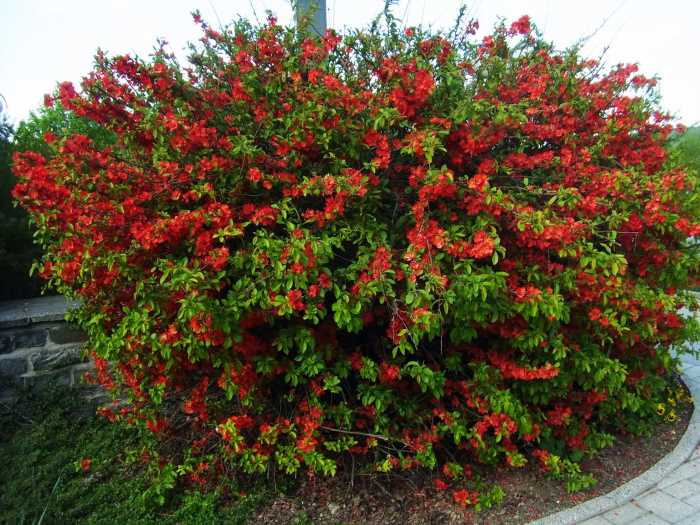

The plant conquers more and more gardens, not only in central Russia, but also in regions with a more severe climate. That is why gardeners are interested in how you can grow quince at home.
What is Japanese quince
The value of this plant is difficult to exaggerate, it not only has an interesting taste, but is also extremely healing. In medical circles, quince is used to treat ailments such as colds, gastrointestinal diseases, liver pathology, and skin.
It is thanks to its medicinal properties that this plant culture has found many admirers among gardeners and gardeners.
In addition to its medicinal properties, quince is incredibly decorative, it can decorate not only a personal plot, its decorative qualities are often used in landscaping city parks, squares and other recreation areas.
Japanese quince is considered a long-liver, it can grow in this place for more than 70 years, and fruiting occurs already in the third year of life. The yield of the plant is amazing, from a tree or bush you can collect from 20 to 100 kg of fruits. Isn't that amazing?
The fruits are stored for a very long time, they can lie until next spring and not deteriorate at all. The longer the harvest is, the more delicious the fruits become, the astringent taste disappears, they become sweeter and softer.
